Forest camping in Curraghchase, Co Limerick / Sous la tente dans la forêt de Curraghchase
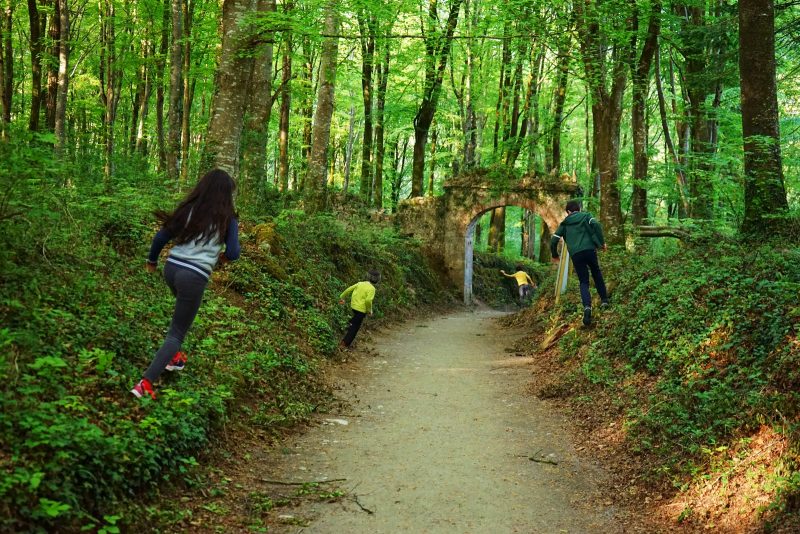
This was our very first time in Limerick. A few years ago, we holidayed on the Ring of Kerry and visited the Burren in neighbouring Co Clare, but never before had we set foot in Limerick.
This being the southwest of Ireland, I expected Limerick to be somewhat similar to its coastal neighbours. Only Limerick doesn’t have a coast. Instead, Limerick guards the Shannon Estuary, where Ireland’s longest river meets the Atlantic Ocean. As a result, the county is one of rolling pastures and historical remains – less Wild Atlantic Way than Ireland’s Ancient East.
Ce fut notre toute première fois dans le comté de Limerick. Il y a quelques années, nous avons visité le Ring of Kerry, puis le Burren dans le comté voisin de Clare, mais jamais nous n’avions mis les pieds en Limerick.
Etant donné qu’il s’agit du sud-ouest de l’Irlande, je pensais que Limerick ressemblerait à ses voisins côtiers. Mais voilà, Limerick est dépourvu d’accès à la mer. En fait, Limerick monte la garde autour de l’estuaire de la Shannon, la plus longue rivière d’Irlande. Ainsi, c’est un comté de pâturages ondoyants et de vieilles pierres – moins Wild Atlantic Way que Terres Ancestrales d’Irlande.
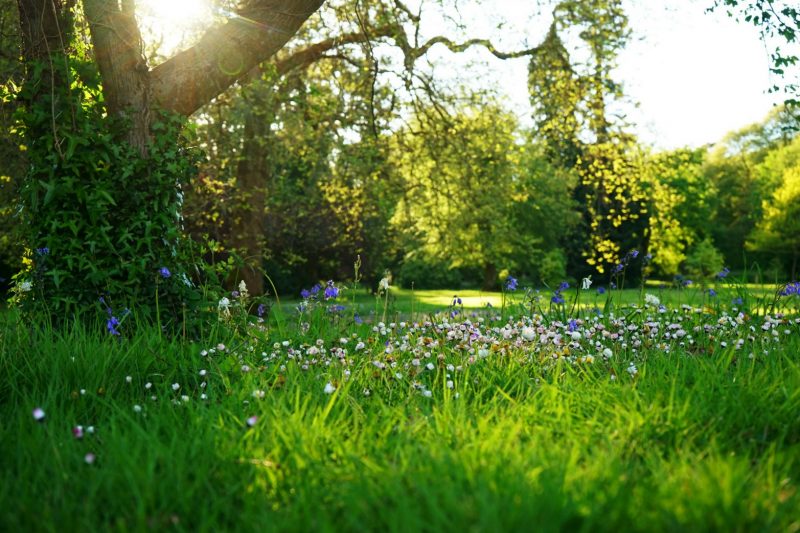
Camping in Limerick
We usually go camping on the June bank holiday weekend – Meath in 2014; Down in 2015; Wexford in 2016; Tipperary in 2017; Cavan in 2018. But this year, for lack of a camper van trip, we decided to go and pitch our family tent (affiliate link) one month early.
A quick search on the Camping Ireland website soon yielded the Curraghchase Caravan & Camping Park. Nestled on the grounds of the eponymous forest park, this gem of a campsite boasts a heartwarming back story.
A lost world
Inspired by the fond memories of the family camping holidays of his childhood, manager Warren Higgins realised his long time dream when in 2015, he took on the mammoth challenge of re-opening the derelict Curraghchase Caravan & Camping Park, closed for 15 years.
When I went to visit it, I found a lost world overgrown in Curraghchase Forest Park. The campsite opened in the late 1970s and closed in the early 2000s. I won a tender from Coillte to lease the campsite and we reopened it in June 2015. It was a terrifying experience to start my first business but the natural beauty of its location spurred me on to the unique possibilities that may lay ahead.
Warren checked us in in the beautiful De Vere Café – he couldn’t have been friendlier or more helpful, his love and pride for the place clearly evident when he mentioned the many red squirrels that had taken residence in the campsite building during all the years it remained closed.
All pitches in the camping field are large, flat and covered in soft grass. Yet it took a few minutes to choose our ideal spot! With that done, it was time to pitch our tent (affiliate link) in the bright sunshine – a ritual that the acorns clearly enjoy helping with. With every passing year, their camping skills improve.
D’habitude, nous allons camper pour le weekend de Pentecôte, au début juin : Meath en 2014; Down en 2015; Wexford en 2016; Tipperary en 2017; Cavan en 2018. Mais cette année, faute de road trip en camping-car, nous avons décidé de planter notre tente familiale un mois plus tôt qu’à l’accoutumée.
Une petite recherche sur le site de Camping Ireland révéla bientôt le Curraghchase Caravan & Camping Park. Blotti dans la forêt domaniale du même nom, il s’agit d’un camping avec une petite histoire à raconter.
Inspiré par les vacances en camping de son enfance, le directeur Warren Higgins réalisa son rêve quand, en 2015, il entreprit de réouvrir le camping de Curraghchase, à l’abandon depuis quinze ans.
Quand je l’ai visité, je suis tombé sur un monde perdu dans la forêt de Curraghchase. Le camping avait ouvert à la fin des années 1970 et fermé au début des années 2000. J’ai remporté un appel d’offres de Coillte pour reprendre le camping et, en 2015, nous l’avons réouvert. C’était terrifiant de me lancer à mon compte mais la beauté de l’endroit m’encourage à explorer le potentiel unique de ce site.
A notre arrivée, Warren se trouvait dans le joli De Vere Café. Il n’aurait pu être plus accueillant ou accommodant, rayonnant d’amour et de fierté pour les lieux quand il parla des écureuils roux qui avaient pris résidence dans le bâtiment du camping pendant les longues années de fermeture.
Tous les emplacements pour tente du camping sont grands, plats et couverts d’une herbe douce et épaisse. Malgré tout, il nous fallu plusieurs minutes avant de choisir le nôtre ! Il était temps de planter notre tente, sous le soleil de printemps – un rituel auquel les graines de chêne se plient de bon cœur. Ils s’améliorent d’année en année.
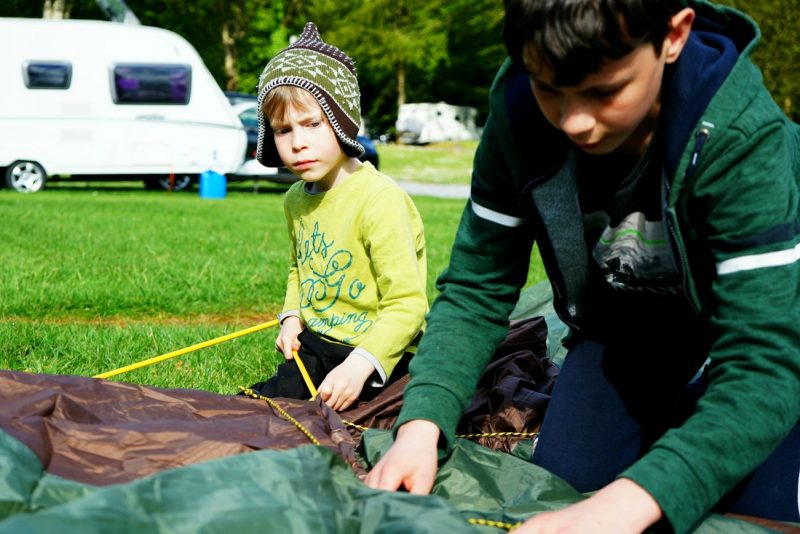
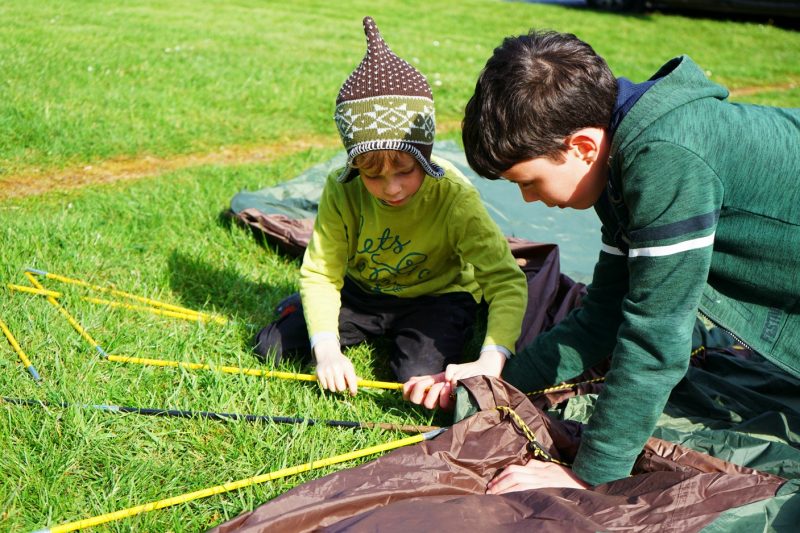
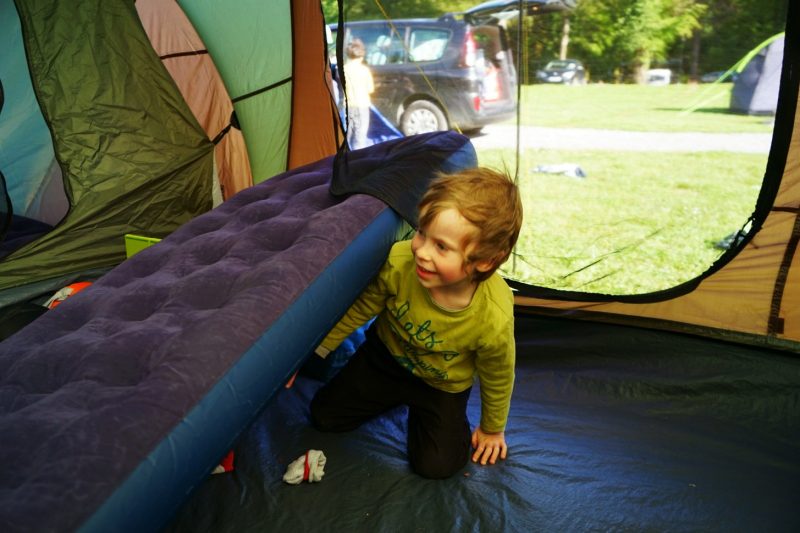
With the tent pitched and the sleeping bags and mats in place, a game of Mölkky (affiliate link), a favourite of our French summers, quickly ensued.
Une fois la tente plantée et les couchages en place, les graines de chêne s’affrontèrent dans une partie de Mölkky, un incontournable de nos étés en France.

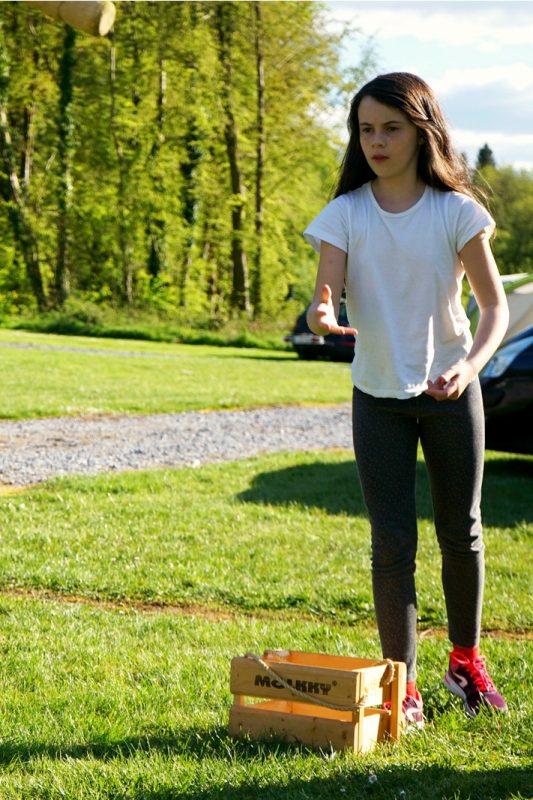
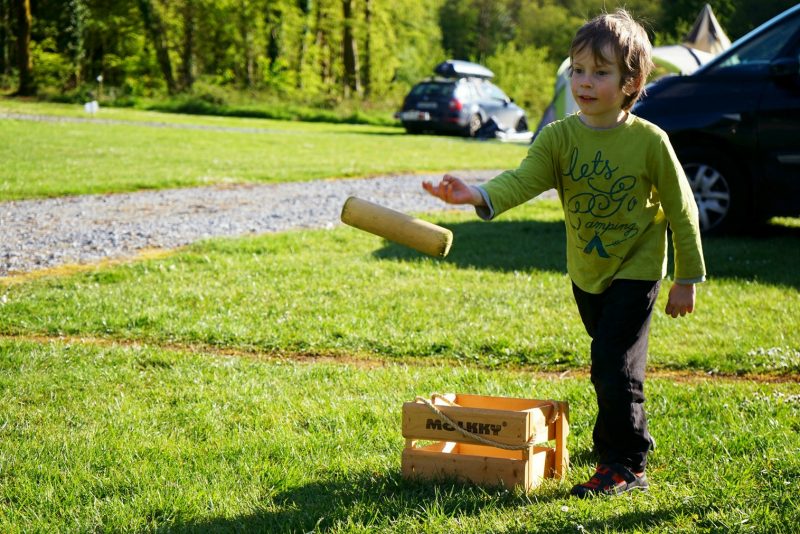
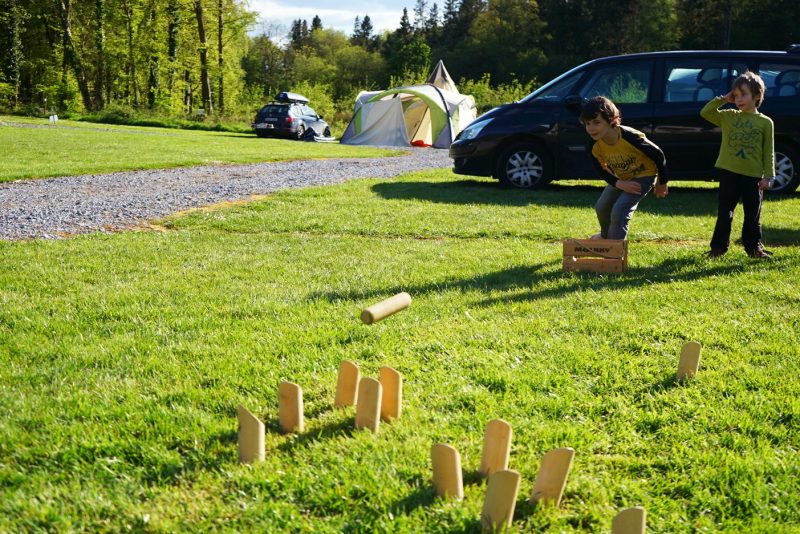
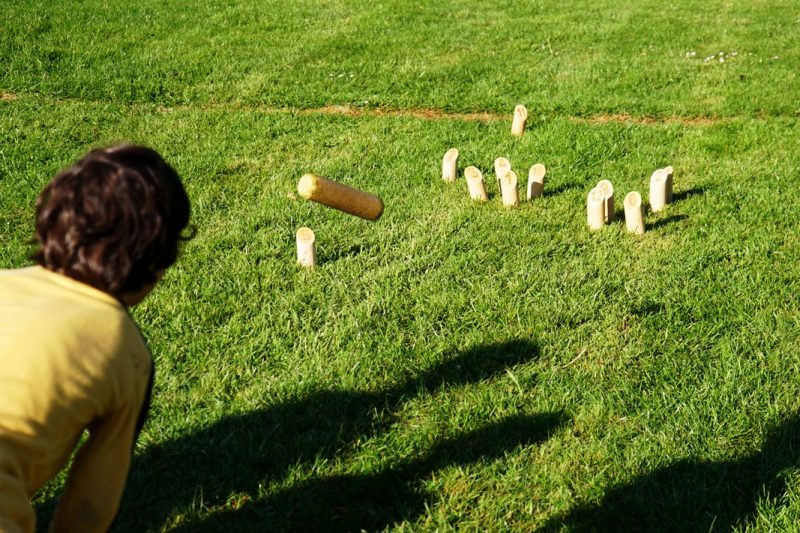
By the time we had eaten our traditional camping dinner of pasta with courgettes, tomatoes and black olives, the sun had set and a blanket of humid cold seemed to come down over our camp, seeping through to our bones. As we looked enviously at the other campers’ campfires, our trusty, and very rusty, firepit (affiliate link) was sorely missed. Earlier in the day, with space at a premium in the car already packed to the rafters, Brian had reluctantly decided not to bring it.
After our coldest night under canvas since winter camping in a tipi some 18 months prior, a unanimous decision was made to source a folding barbecue (affiliate link) without delay.
Une fois avalé notre traditionnel dîner de camping (des pâtes accompagnées de courgettes à l’ail, tomates et olives noires), le soleil s’était couché et un voile humide et glacé sembla envelopper notre campement. Comme nous lorgnions envieusement les braseros des voisins, notre fidèle braséro tout rouillé nous manqua terriblement. Avant le départ, avec la voiture déjà pleine à craquer, Brian avait renoncé à l’emporter.
Mais après une nuit sous la toile la plus froide depuis notre bivouac dans un tipi quelque 18 mois auparavant, la décision fut prise à l’unanimité de dégoter un barbecue pliant sous les plus brefs délais.
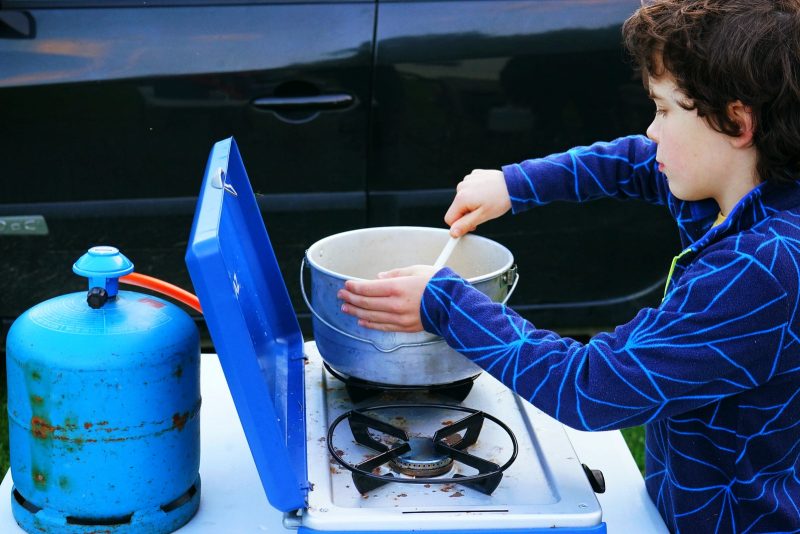
Flying Boat Museum, Foynes
Sunday was the day we visited the intriguing Flying Boat Museum in Foynes, Co Limerick, where the Irish coffee was invented, no less!
In the 1930s-40s, the era of transatlantic flights was still in its infancy. While Shannon Airport was being built, the deep-water port of Foynes, on the Shannon Estuary, was used as a temporary base for the very first passenger flights between western Europe and New York. The so-called flying boats would take off and land on the sheltered waters of Foynes, until World War II put an end to this epic period of aviation history.
There is a life-size replica of a Boeing 314 Clipper flying boat is “moored” by the museum. The acorns didn’t have much time for the ocean liner luxury of the passenger deck, but they loved “flying” this beast of an aircraft!
Au musée des Bateaux volants de Foynes
Le lendemain, nous avons visité le mystérieux Flying Boat Museum de Foynes, Co Limerick, là le fameux Irish coffee (café au whiskey nappé de crème fouettée) fut inventé, rien que ça !
Dans les années 1930-40, l’ère des vols transatlantiques en était encore à ses balbutiements. Comme l’aéroport de Shannon, sur la rive nord de l’estuaire, était en cours de construction, le port de Foynes, sur la rive sud, servit de base temporaire aux tout premiers vols de passagers entre l’Europe de l’Ouest et New York. Les énormes bateaux volants de Pan Am décollaient et atterrissaient sur le fuselage dans les eaux calmes de Foynes, jusqu’à ce que la Seconde Guerre mondiale mit un terme à cette période épique de l’aviation civile.
La réplique grandeur nature d’un Boeing 314 Clipper est “ancrée” au musée. Les graines de chêne ne perdirent pas de temps à admirer le luxe inouï du pont passager, mais ils adorèrent jouer à “piloter” cette énormité !
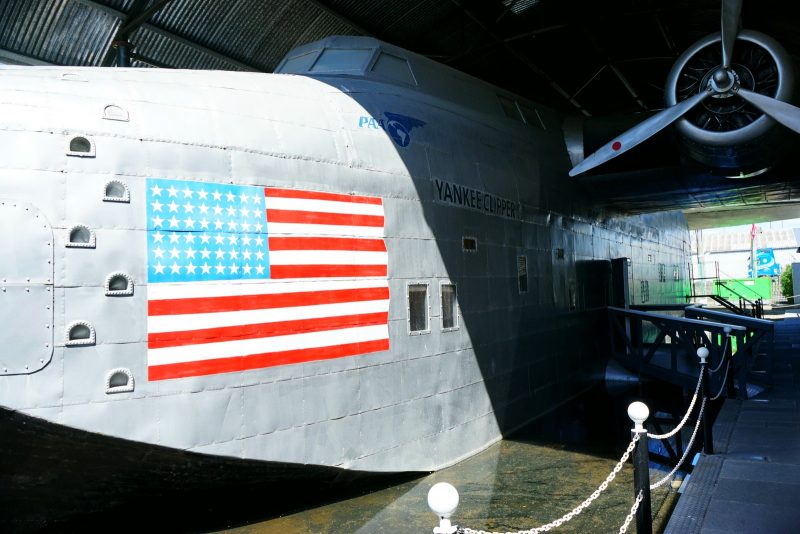
Life size replica of a Boeing 314 Clipper flying boat /
Réplique grandeur nature d’un bateau volant Boeing 314 Clipper.
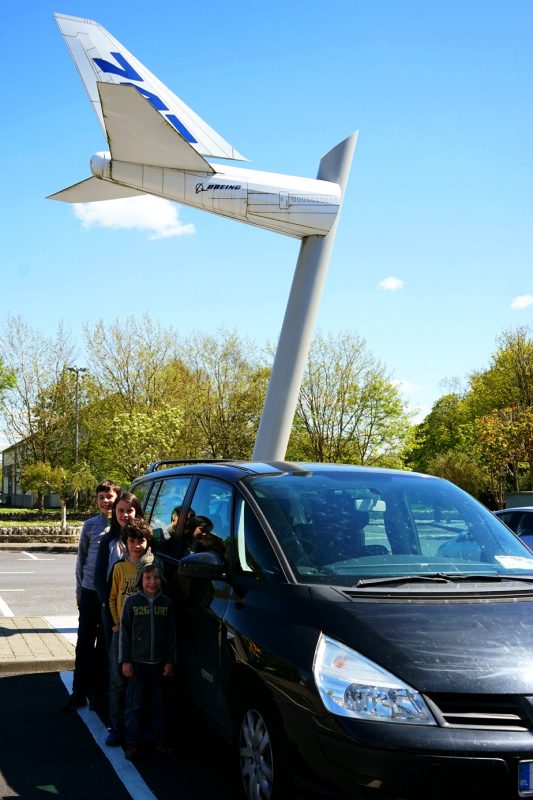
Our very own “flying boat” /
Notre bateau volant à nous.
Unsurprisingly, the local supermarket did not stock folding barbecues. Dismissing disposable barbecues (too much waste for such short-lived enjoyment, plus they’re laden with petrochemicals), we bought instead a baking tin. Yes, that’s right – a square cake tin that rested on a few stones to keep it off the lush grass of the campsite.
While the acorns gathered some firewood in the nearby forest, I started cooking dinner – a Mexican leek & black bean chilli taken from The Happy Pear (affiliate link), the first cookbook by twin chefs Stephen & David Flynn, which the acorns gifted me for my birthday.
This book has been a godsend in my climate-related efforts to eat less meat and dairy. But surely, making one of its recipes while camping would be the ultimate test! Well, this tasty, warming one-pot recipe delivered in spades!
Meanwhile, Brian and the acorns had got the campfire going in our makeshift firepit, and it soon was time to toast marshmallows over the flames. As night slowly descended over our family camp, the acorns asked for a spooky story or two.
Sans surprise, le supermarché local ne stockait pas de barbecue pliant. Rejetant d’emblée les barbecues jetables (à usage unique et gorgés d’adjuvants pétrochimiques), nous avons acheté un moule à gâteau. Oui, vous avez bien lu : un moule métallique carré, reposant sur quelques pierres pour ne pas endommager la belle pelouse du camping.
Pendant que les graines de chêne ramassaient du bois mort dans la forêt adjacente, je commençai à préparer le repas : un chili végétarien aux poireaux et poivrons pris dans The Happy Pear, le premier livre de cuisine des jumeaux irlandais Stephen et David Flynn, que les graines de chêne m’ont offert pour mon anniversaire.
Ce livre s’est avéré une bénédiction dans mes efforts pour réduire notre consommation de viande et de produits laitiers – car la production de ces piliers de l’alimentation occidentale est responsable d’une bonne part de nos émissions de gaz à effet de serre.
Bénédiction ou pas, recréer une de leurs recettes en camping serait sûrement le test ultime. Eh bien, ce chili s’est avéré aussi savoureux et réconfortant à la maison qu’en plein air !
Cependant, Brian et les graines de chêne avaient allumé le feu dans notre braséro de fortune, et il fut bientôt temps de faire griller des chamallows sur les flammes. Comme la nuit tombait lentement sur notre campement, les graines de chêne réclamèrent une histoire qui fait peur.
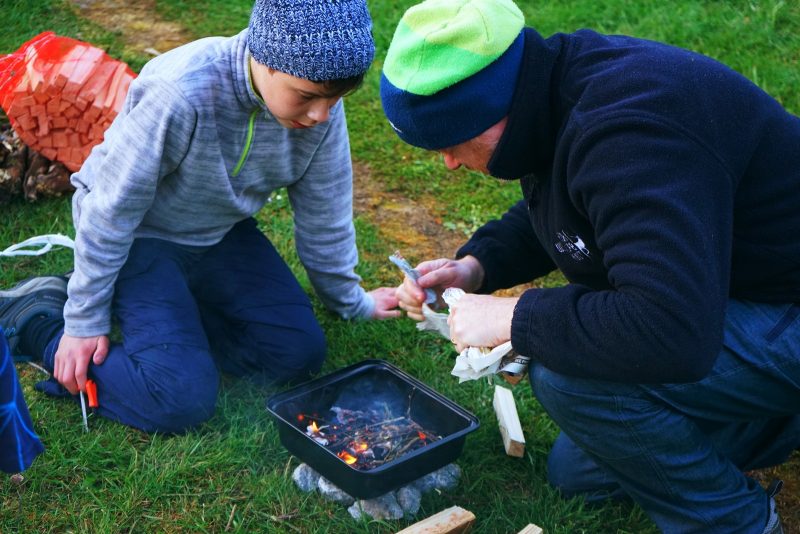
Lighting the fire in a cake tin /
Feu de camp dans un moule à gâteau.
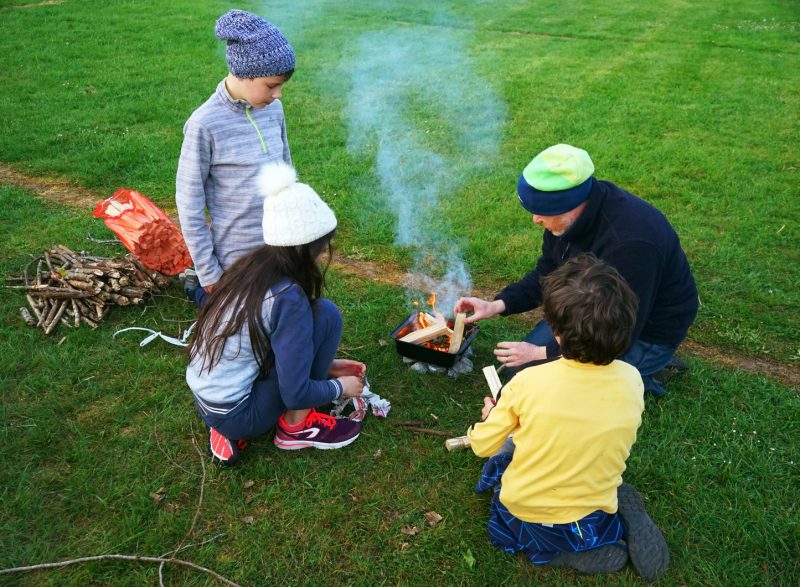
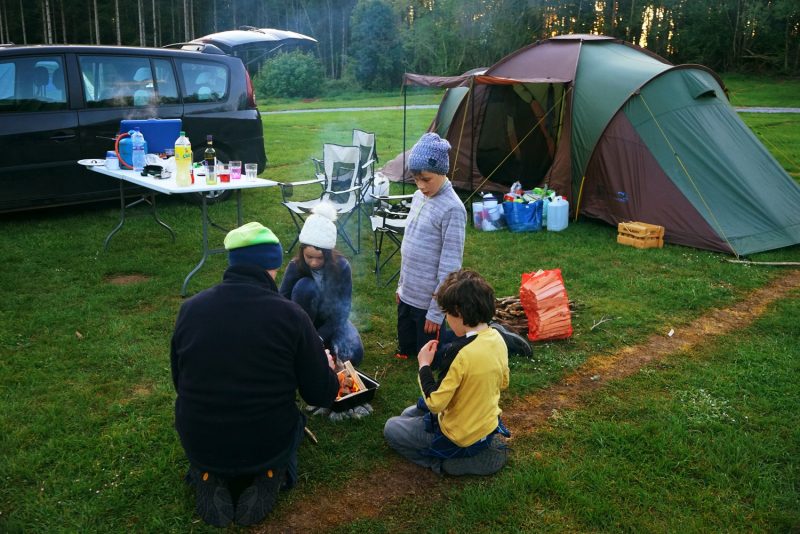
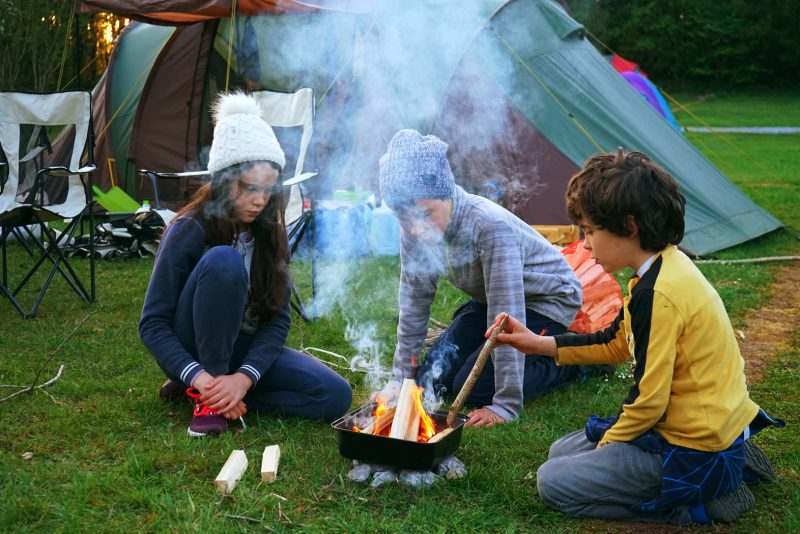
Exploring Curraghchase, Co Limerick
Limerick is a land of myths and legends, of ancient sites and living history. Curraghchase is no exception. As you drive towards the campsite, a crumbling wall on the left meanders through the forest, with an arched stone doorway to mark the entrance of the forest park.
For over 300 years, Curraghchase was the former stately home of the De Vere family, and the birthplace of Irish poet Aubrey de Vere (1814-1902).
The house was destroyed by fire in 1941 and only the outer walls remain today. However, this has not deterred the Lesser Horseshoe Bat (Rhinolophus hipposideros) from making the cellars of the house its preferred hibernation site. It is the largest known site in Co Limerick for this protected bat species.
The estate was bought by the Irish State in 1957, and it is now a Coillte-run forest park, complete with playground, barbecue facilities, and 8km of marked trails around the lakes and through the mixed woodland.
A la découverte de Curraghchase
Limerick est une terre de mythes et de légendes, de sites millénaires et d’histoire vivante. Curraghchase ne fait pas exception. Sur la route d’accès au camping, un long mur croulant serpente dans le sous-bois, jusqu’à une porte de pierre qui marque l’entrée de la forêt.
Curraghchase fut la demeure ancestrale de la famille De Vere pendant plus de trois siècles, et le berceau du poète irlandais Aubrey de Vere (1814-1902).
La maison fut détruite par un incendie en 1941, et seuls en restent les murs extérieurs. Ceci n’a pas empêché une colonie de petits rhinolophes (Rhinolophus hipposideros) de choisir les caves de la maison pour hiberner. C’est le plus important site connu en Limerick pour cette chauve-souris protégée.
Le domaine fut acquis par l’Etat irlandais en 1957, et il s’agit maintenant d’une forêt domaniale publique, disposant d’une aire de jeux, de colonne pour barbecue et de 8 km de sentiers balisés autour des lacs et dans la forêt.
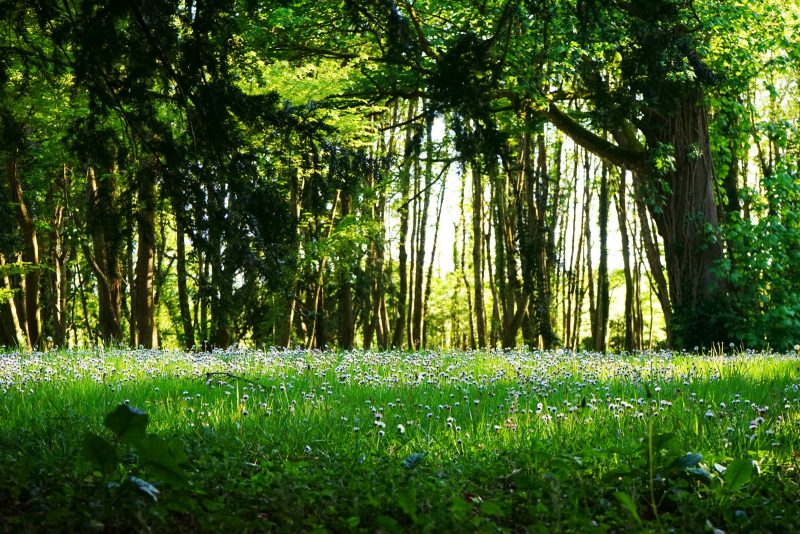
Starting from the campsite, we first walked through the beautiful arboretum. Beyond the stone nook and seat where Aubrey de Vere used to meditate, the rolling lawns were awash with flowers in the late afternoon sunshine – a carpet of tiny daisies, with a few bluebells and cowslips here and there, in the shade of the towering trees. Little birds swooped in and out of their nest in the hollow of a stately cedar.
The De Vere family had, over the years, gathered a substantial collection of specimen trees and shrubs, most of which are still visible today.
Leaving behind a horn-like stick that they had found on the way, the acorns disappeared under the curtain-like leaves of a huge weeping willow; ran to the sweeping terrace at the front of the mansion, only to roll down the lawn; and scaled the enormous branches of a cedar on the way down to the playground.
Partant du camping, nous avons d’abord traversé le superbe arboretum. Au-delà de la niche et du siège de pierre où Aubrey de Vere aimait à méditer, les pelouses ondoyantes étaient revêtues de fleurs sous le soleil de fin d’après-midi – un tapis de pâquerettes minuscules, avec çà et là quelques jacinthes des bois et coucous, à l’ombre d’arbres formidables. Des oiseaux allaient et venaient autour de leur nid dans le creux d’un énorme cèdre.
La famille De Vere avait, au fil des ans, rassemblé une belle collection d’arbres et arbustes, la plupart desquels sont encore visibles de nos jours.
Abandonnant un morceau de bois qui ressemblait à s’y méprendre à un cor de chasse, les graines de chêne disparurent sous le rideau de feuilles d’un saule pleureur géant ; coururent jusqu’à l’élégant perron de la maison, avant de dévaler la pelouse en roulades ; et, en route vers l’ère de jeux, escaladèrent les branches énormes d’un cèdre.
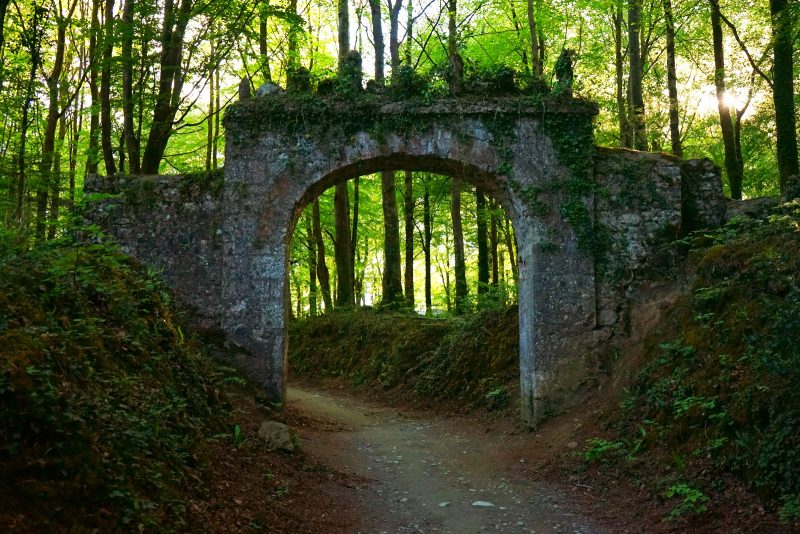
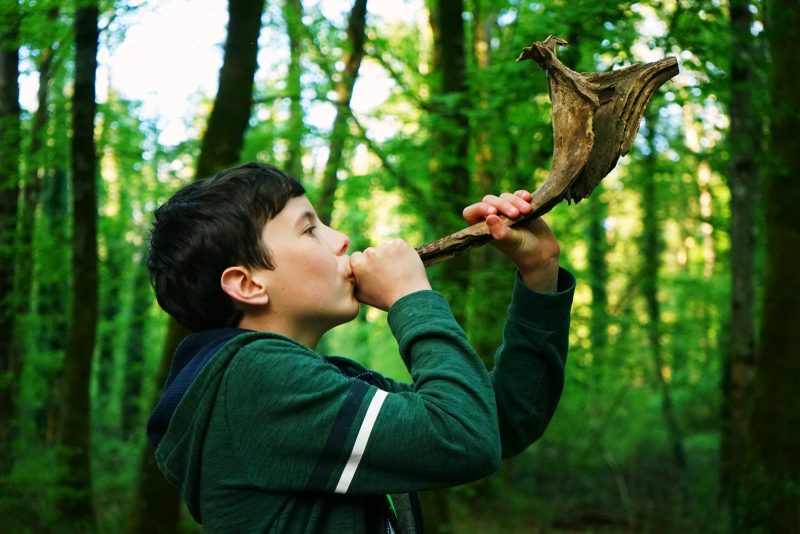
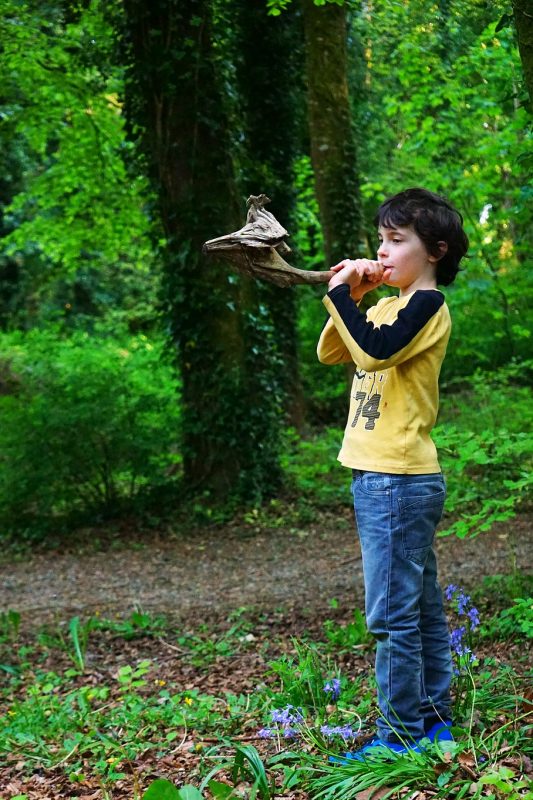
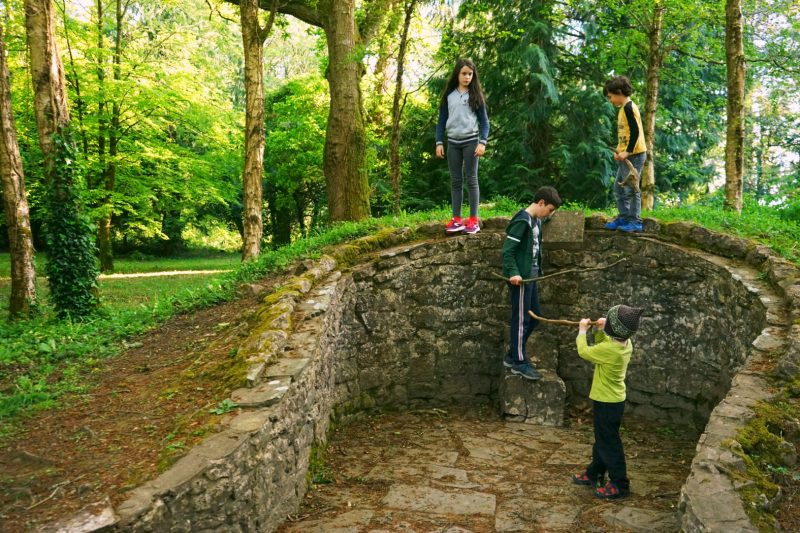
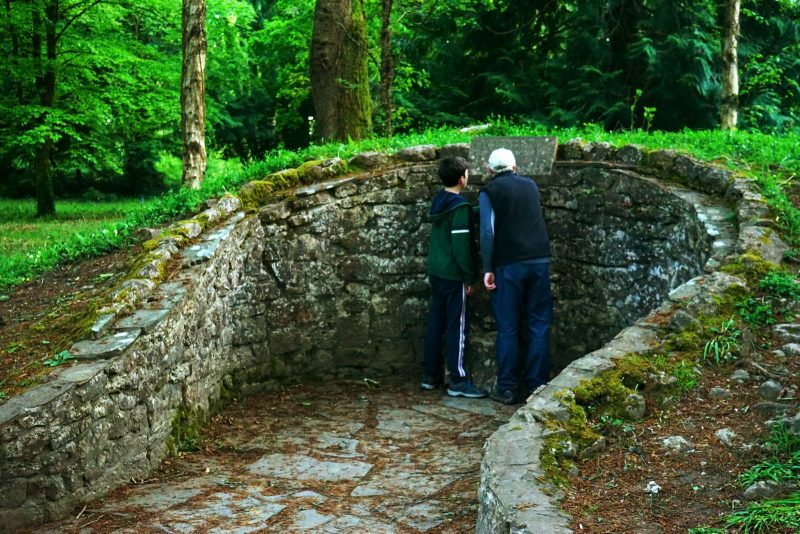
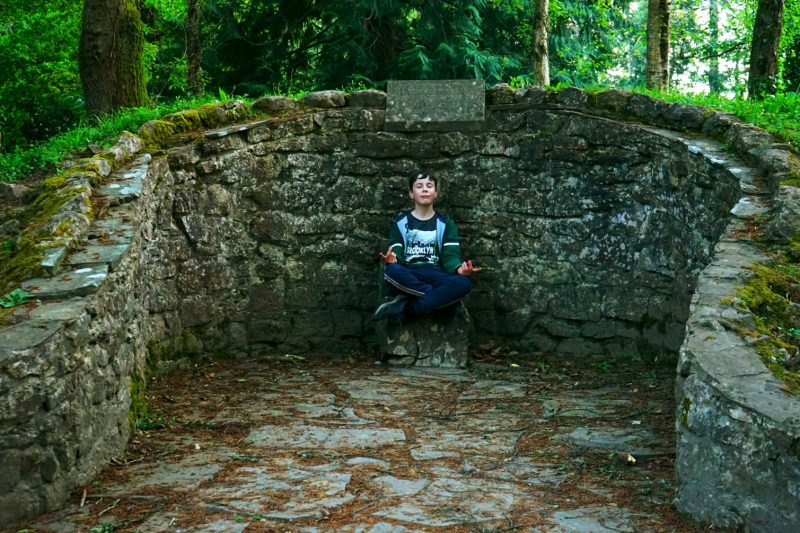
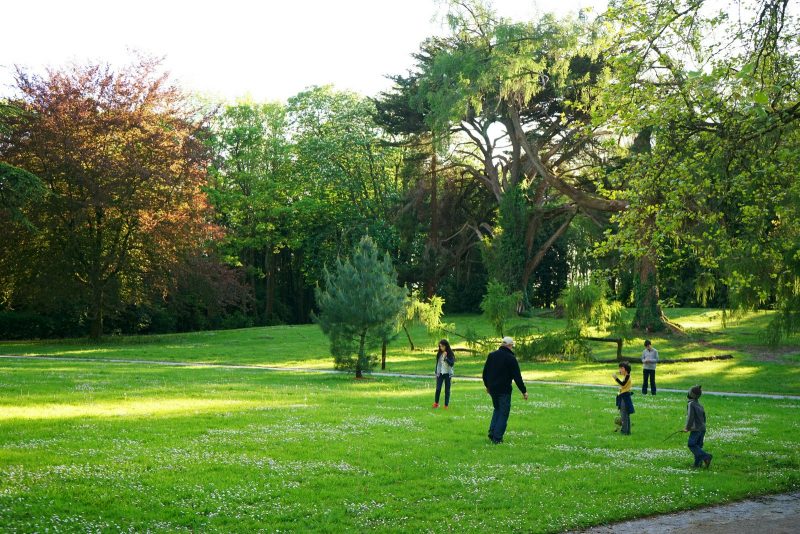
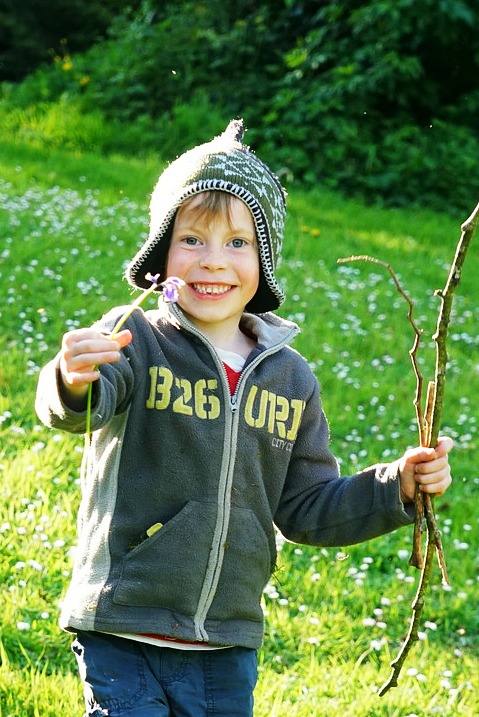
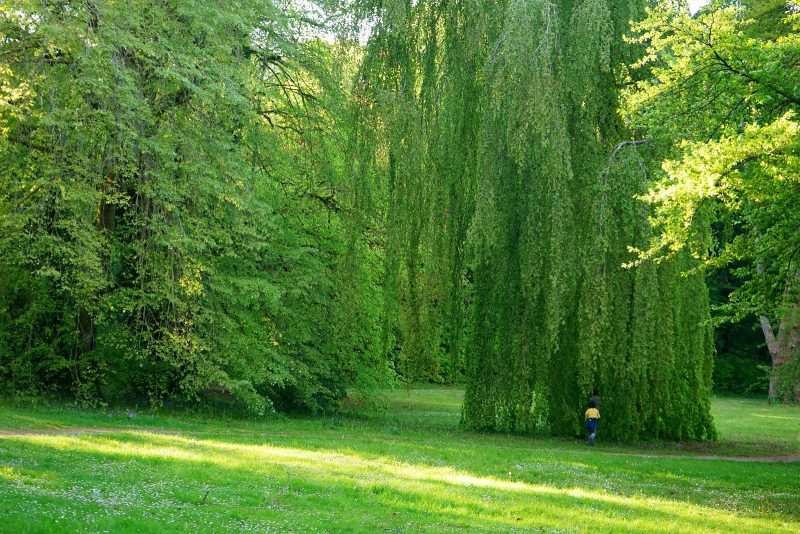
Weeping willow / Saule pleureur
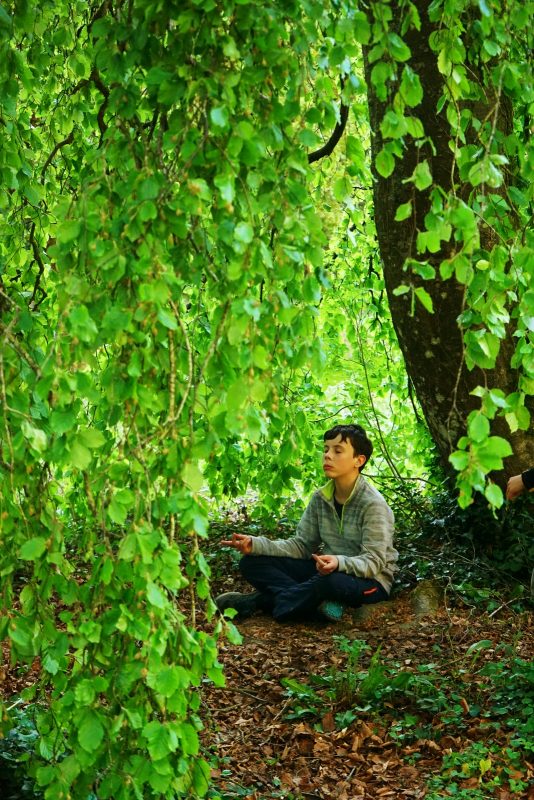
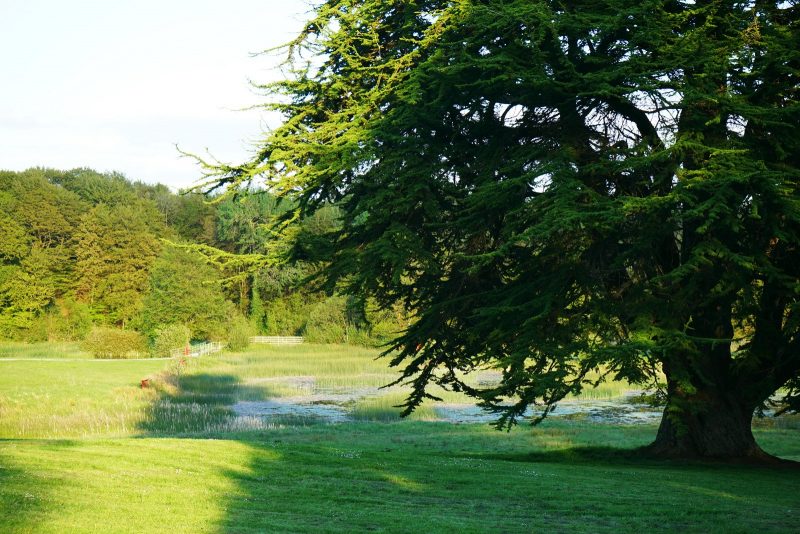
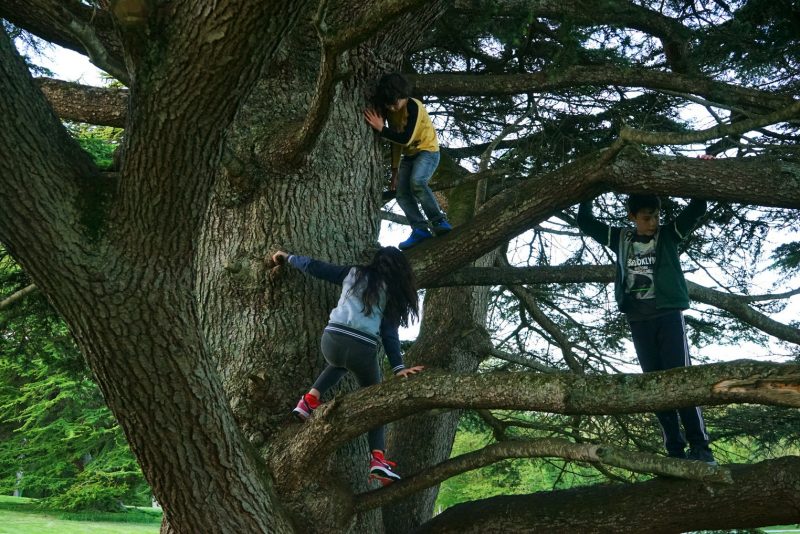
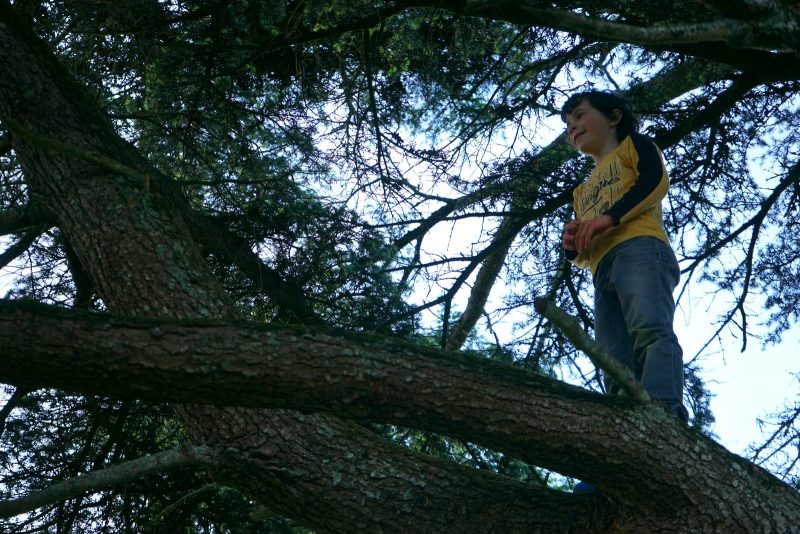
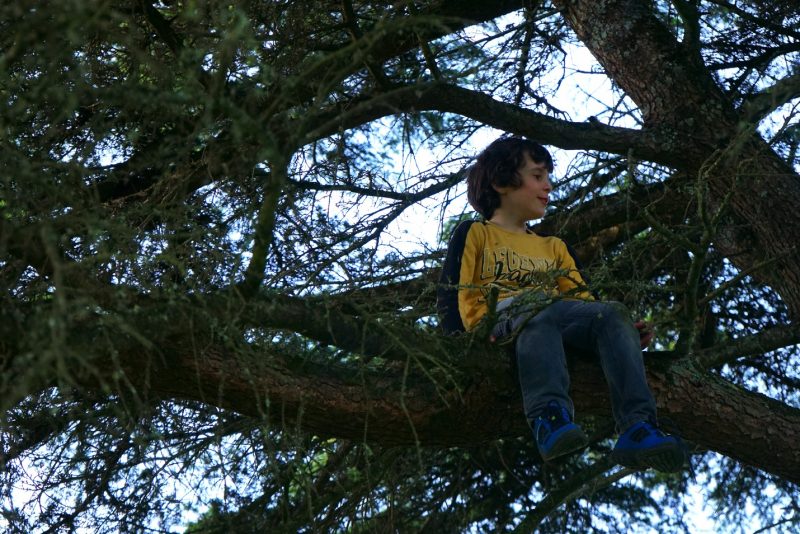
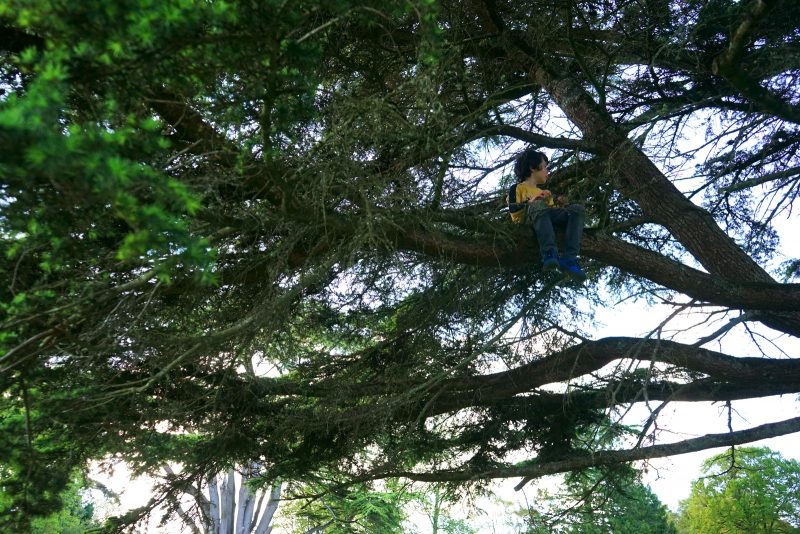
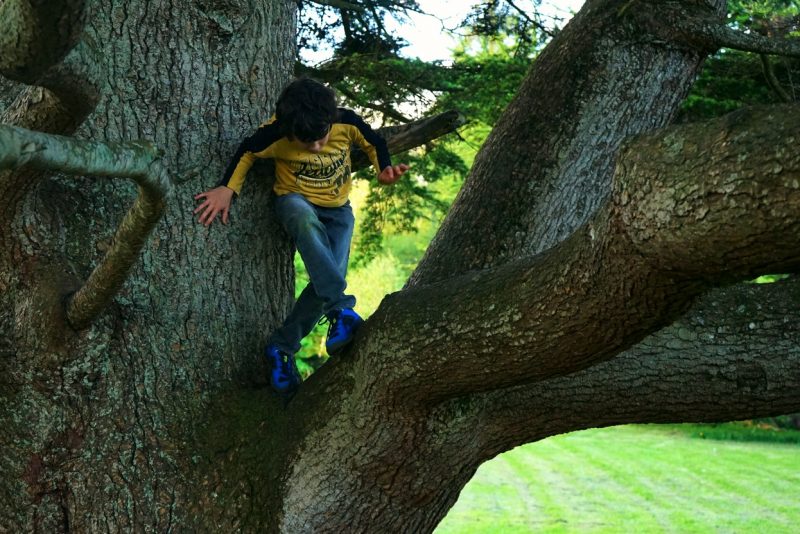
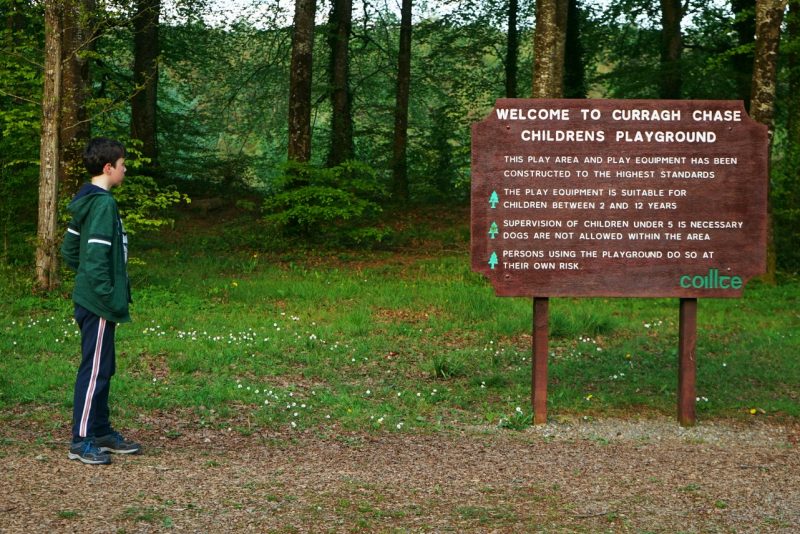
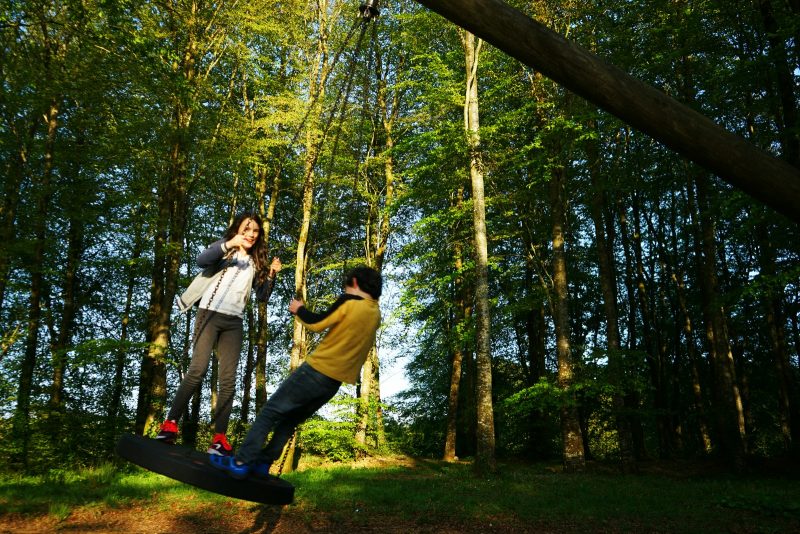
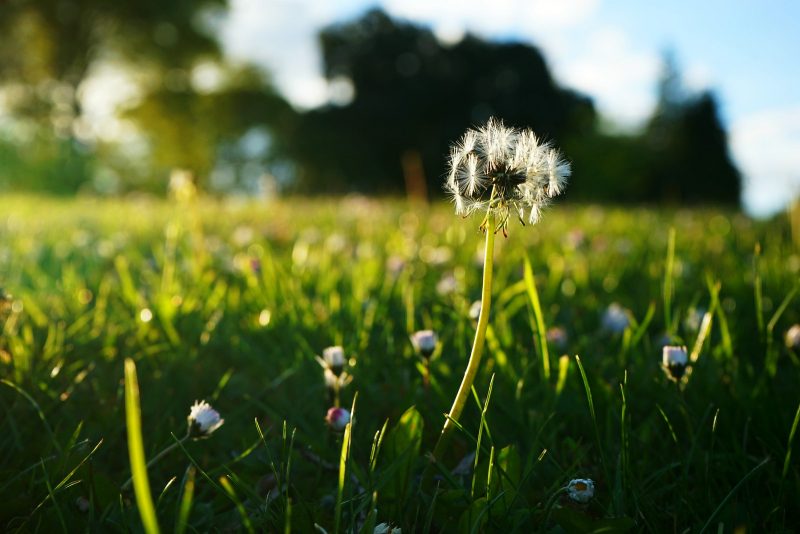
All walking/cycling trails start from the car park. Enticed by the prospect of an ancient cave, limestone cliffs under the trees and Glenisca Lough, we chose the Glenisca Trail (see trail map here). In the end, for lack of proper signposts, we more or less followed the Lake Trail, thus missing Glenisca Lough altogether.
It still was a lovely walk in the woods, with dappled sunlight on the forest floor and birdsong echoing in the canopy.
Tous les sentiers pédestres/cyclables démarrent au parking. Attirés par la perspective d’une grotte mystérieuse, de falaises calcaires dans le sous-bois et du lac Glenisca, nous avons opté pour le sentier vert de Glenisca (voir plan des sentiers ici). En fin de compte, faute de balises, nous avons plus ou moins suivi l’itinéraire bleu et avons ainsi manqué Glenisca Lough.
Ce fut indubitablement une superbe balade en forêt, avec la lumière tamisée du soleil éclairant çà et là le sous-bois et le chant des oiseaux résonnant dans la canopée.
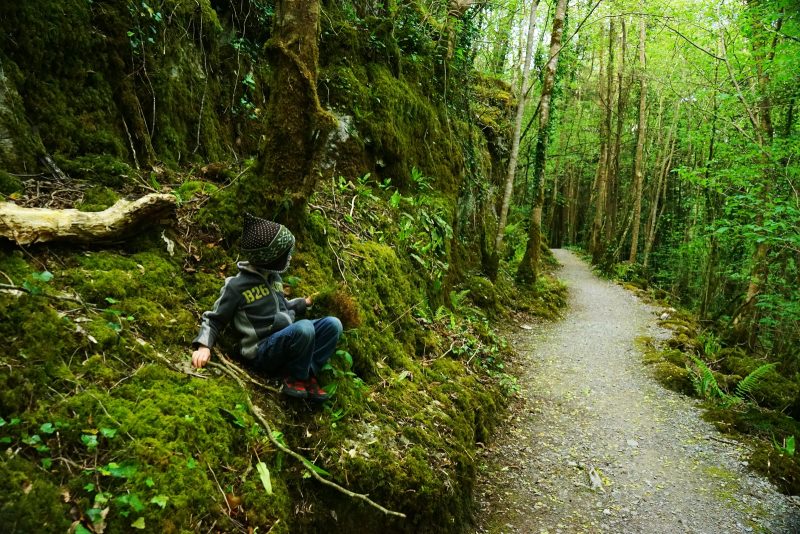
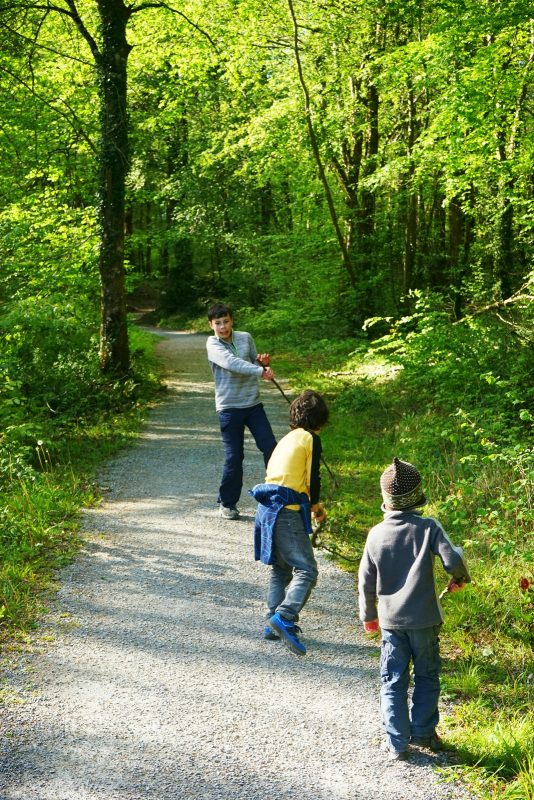
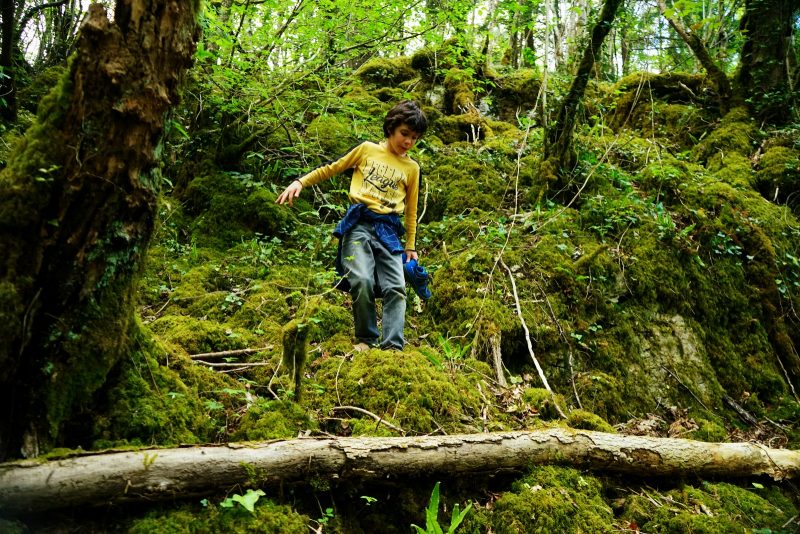
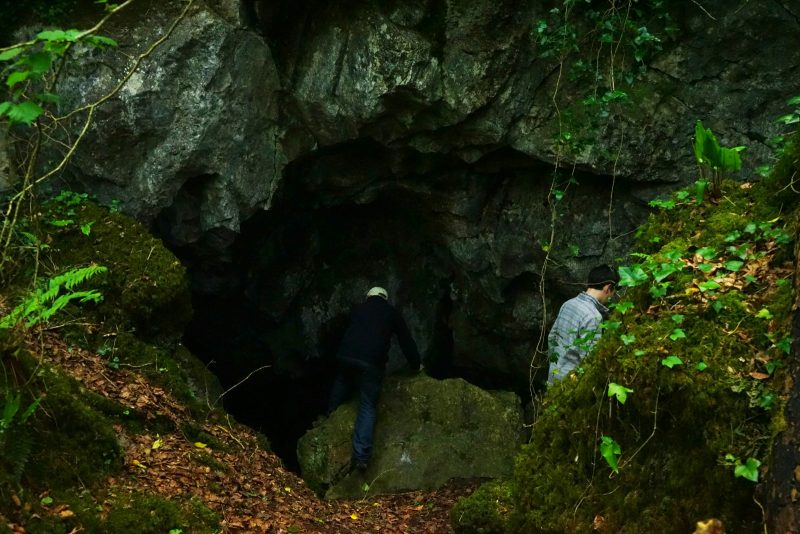
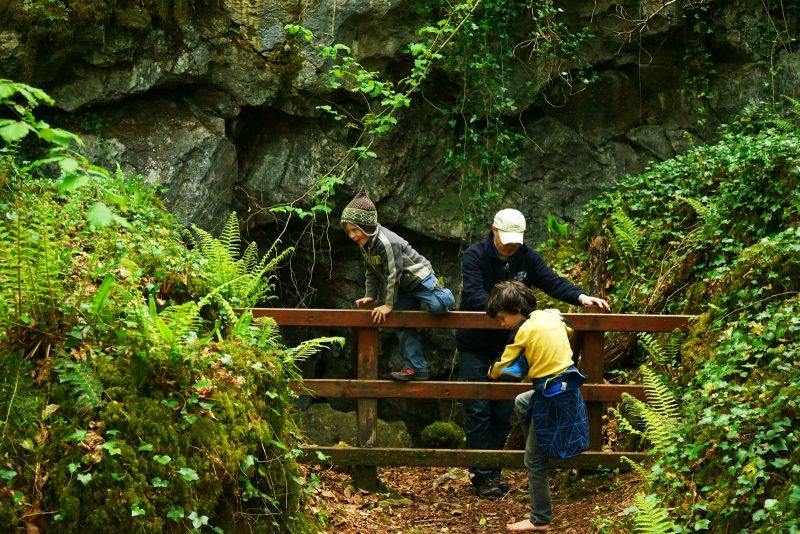
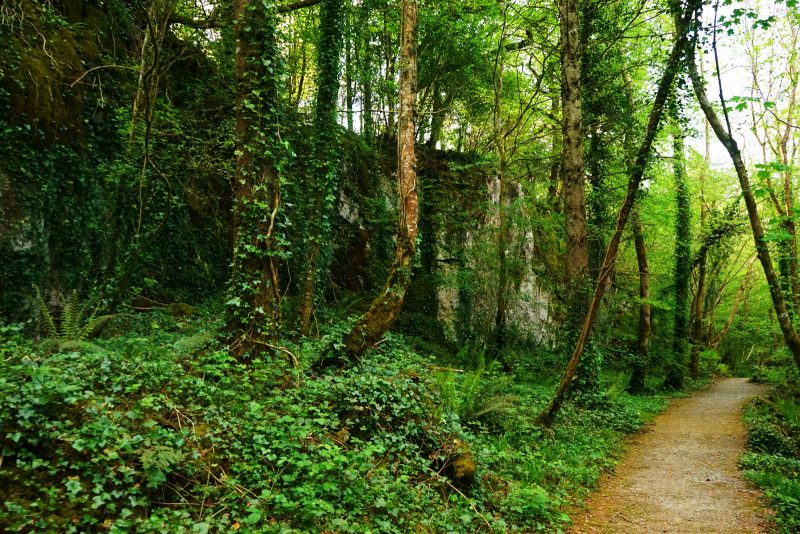
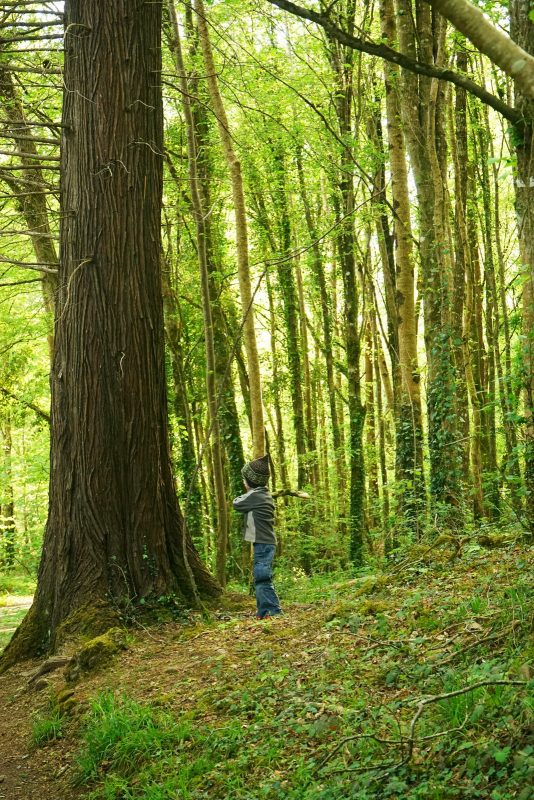
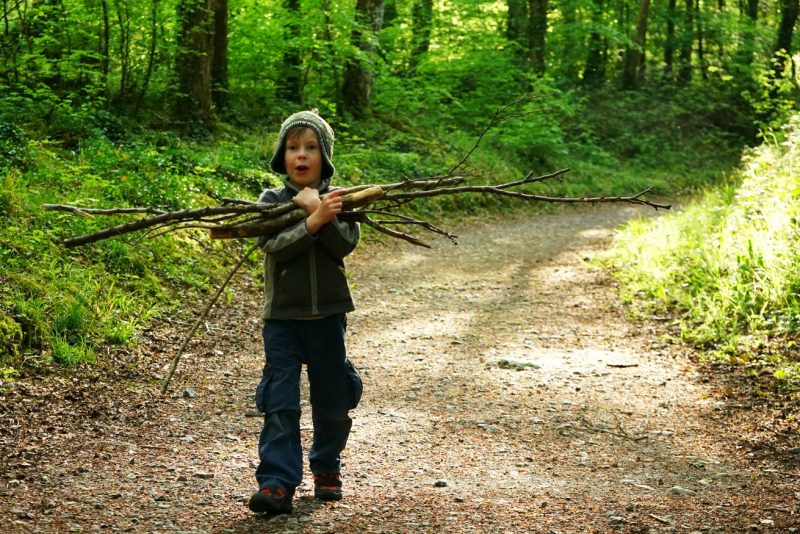
Gathering firewood along the way /
Ramassant du bois pour le feu de camp au fil du chemin.
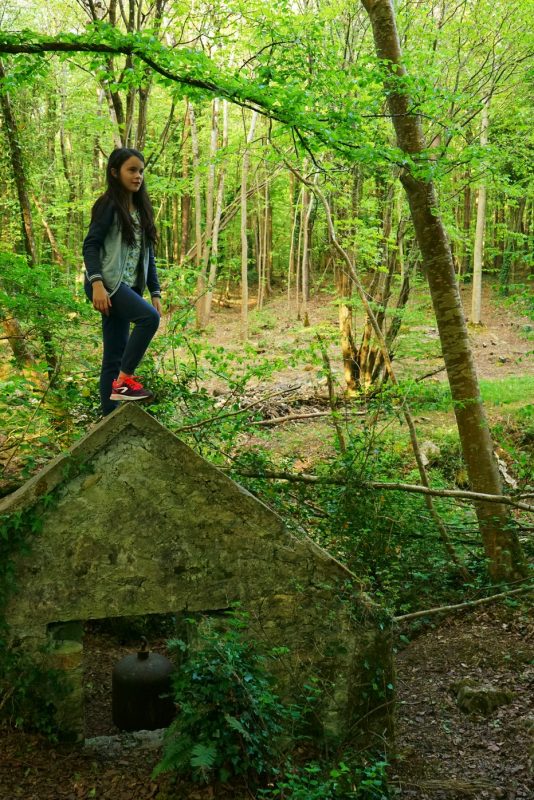
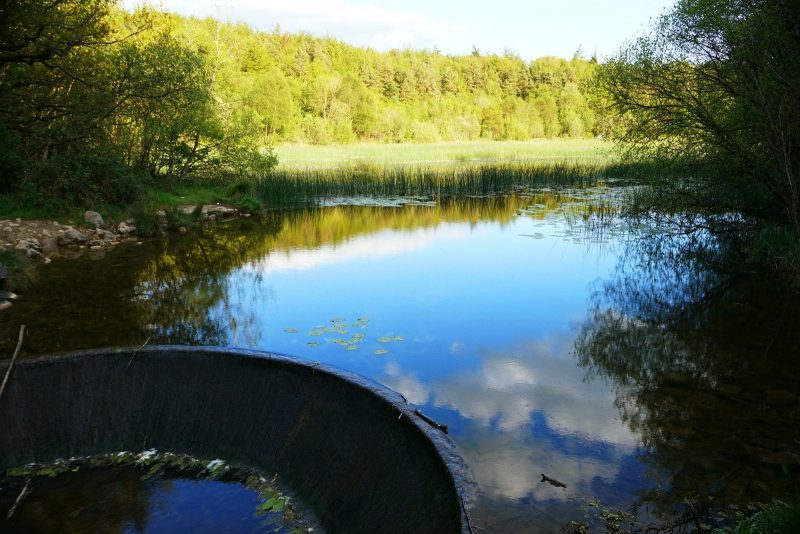
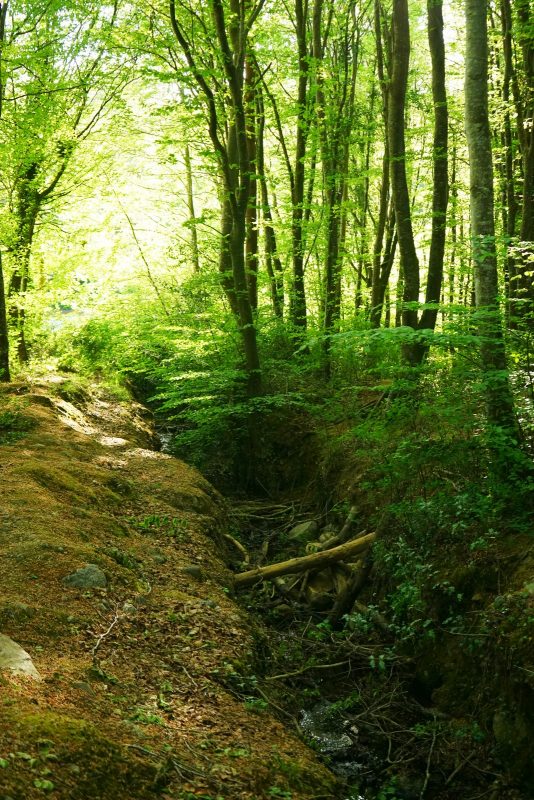
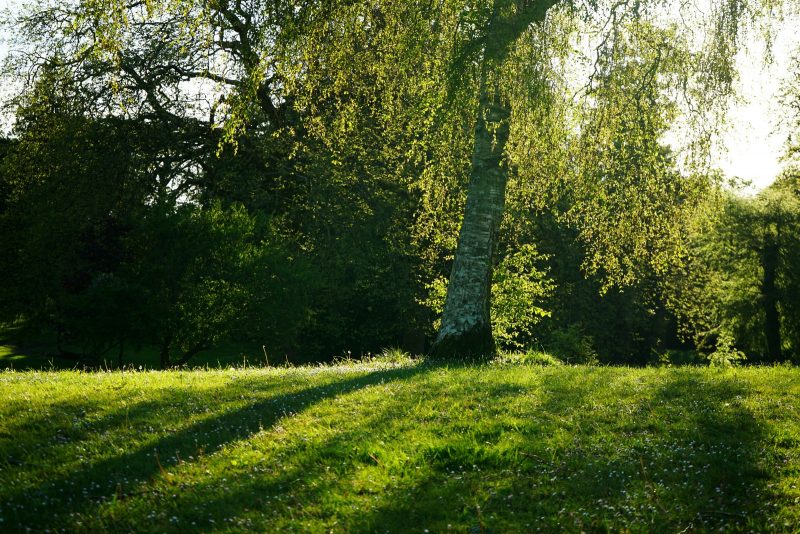
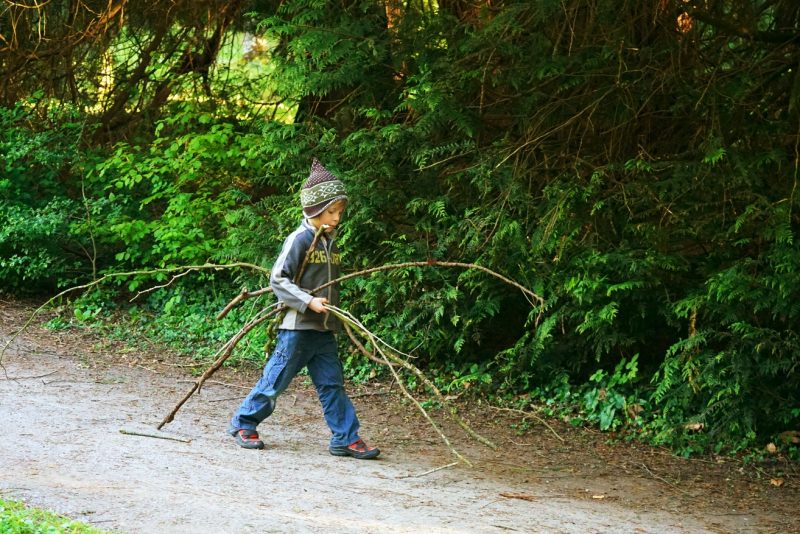
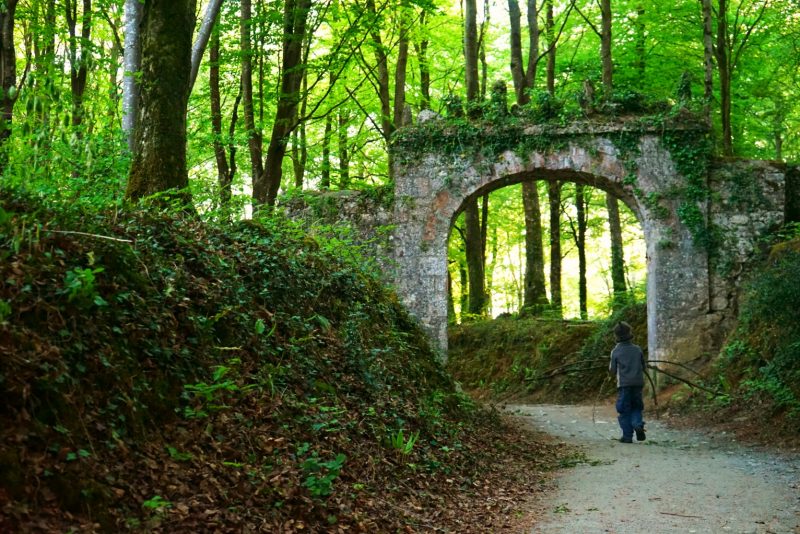
On the final morning morning of our camping weekend in Limerick, we slowly packed up and loaded the car – always a challenge and a fun time, when the acorns pile up on the folded tent to get enough air out of it so it fits in the carry bag.
It was hard to leave Curraghchase Caravan & Camping Park, but the long weekend was about to yield another highlight – before the long drive back home, we went to explore the ancient site of Lough Gur, a true gem of Ireland’s Ancient East.
Pour notre dernier matin de camping à Curraghchase, nous avons lentement levé le camp et chargé la voiture – à la fois une épreuve et un bon moment, surtout quand les graines de chêne se sont empilés sur la tente juste pliée pour la dégonfler juste assez pour qu’elle rentre dans le sac.
Quitter Curraghchase Caravan & Camping Park a été difficile, mais ce long weekend de camping était sur le point de nous donner un autre temps fort : avant le long trajet de retour, nous somes allés explorer le site préhistorique de Lough Gur, un véritable joyau des Terres ancestrales d’Irlande.
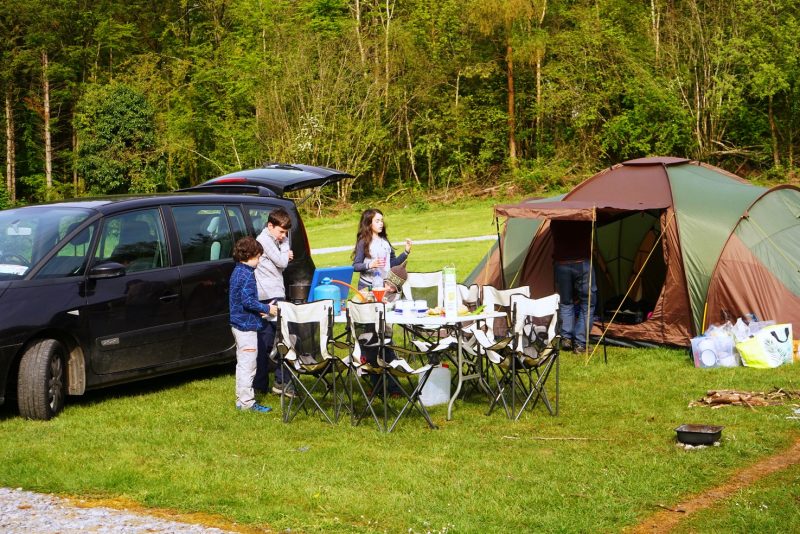
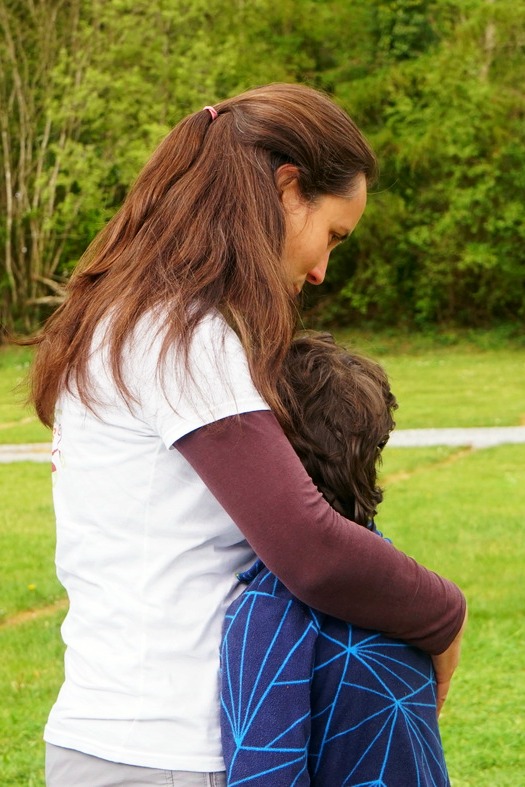
Always hard to say goodbye to a camping friend /
Dur dur de dire au revoir aux copains de camping !
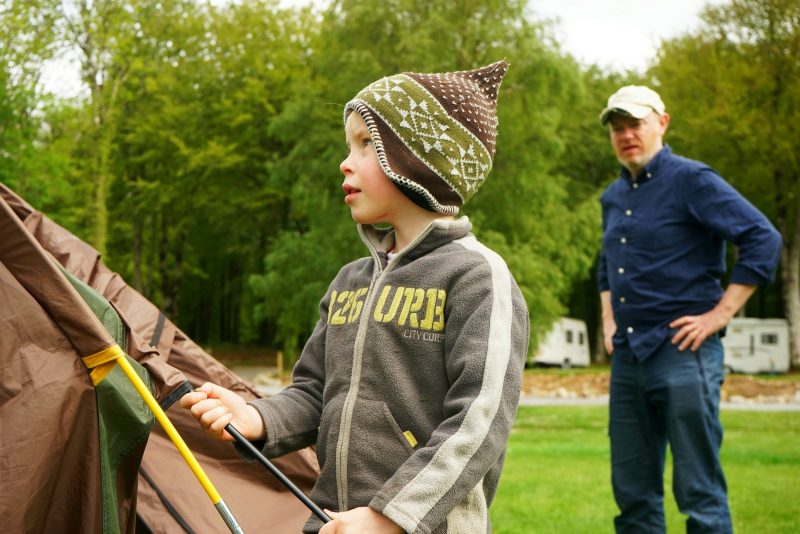
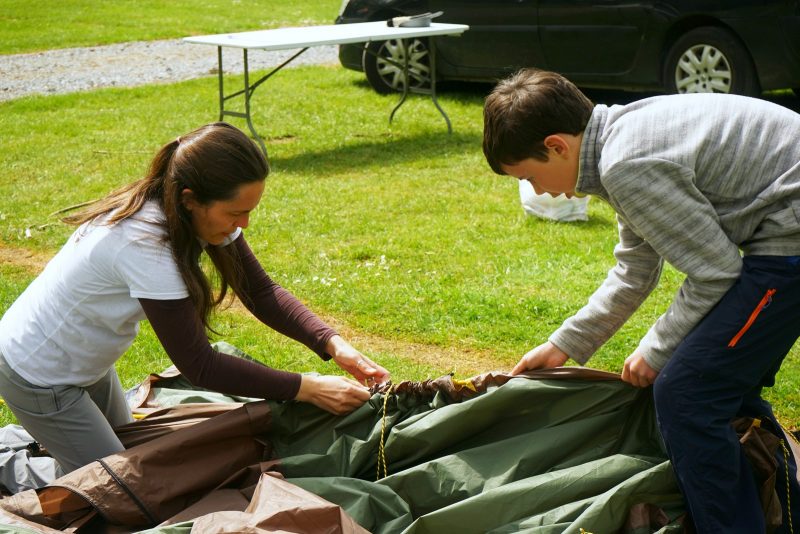
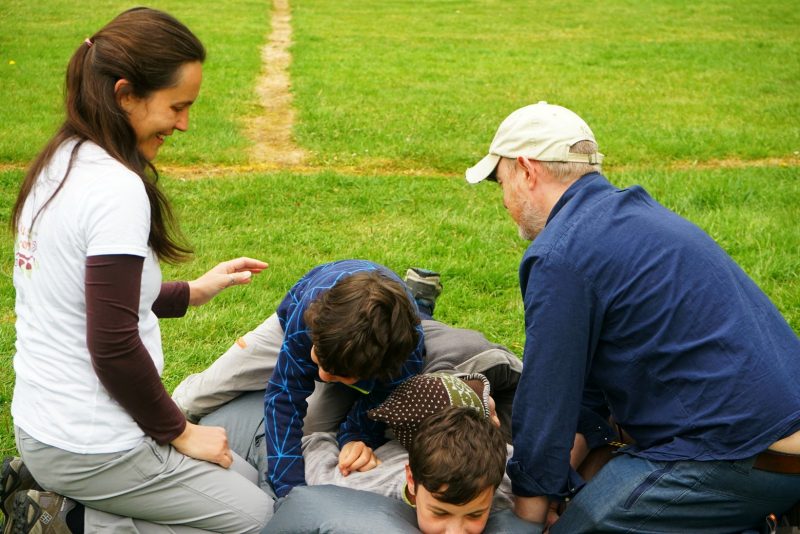
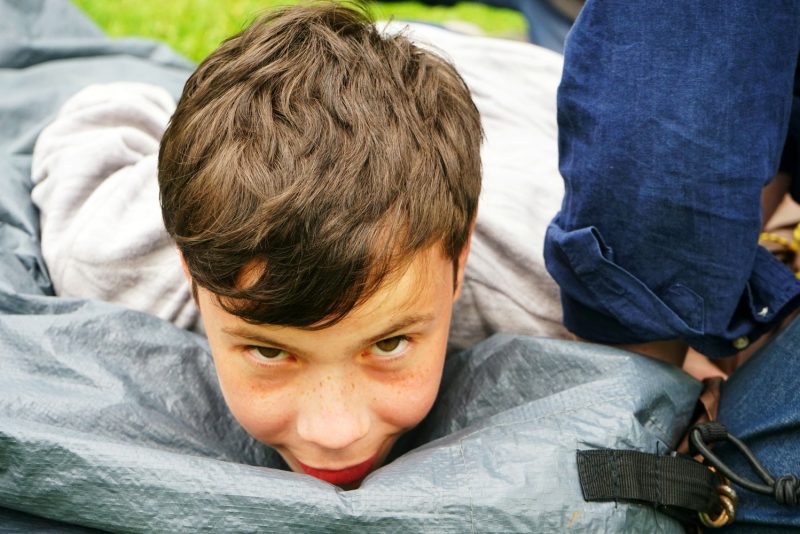
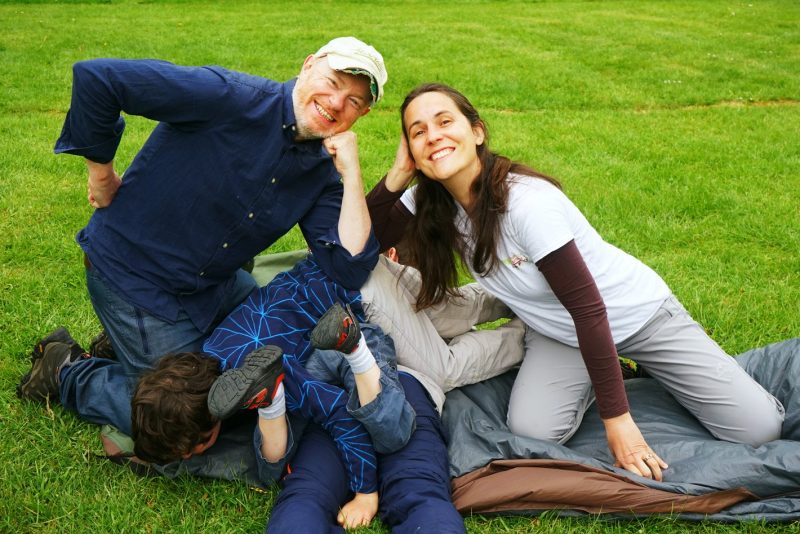
Job done! (No children were injured in the packing of this tent) /
Terminé ! (Aucun enfant ne fut blessé pendant le rangement de cette tente)
Practical information
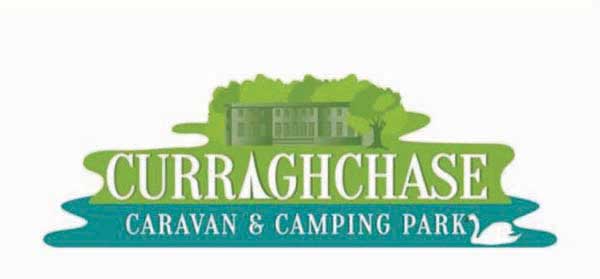
Curraghchase Caravan & Camping Park
Curraghchase Forest Park
Kilcornan
Co Limerick
V94 KP8H
Tel. +353 061 396349
Email info@curraghchasecaravanpark.ie
Wonderfully spacious, perfectly placed and incredibly enticing, Curraghchase Caravan & Camping Park is uniquely nestled in the beautiful grounds of Curraghchase Forest Park, Co Limerick.
The campsite is accessed through a barrier system upon entering the forest park. Advance booking is essential to receive your own personalised code for the entry & exit barriers.
Also included: free hot showers, 24-hour security, De Vere Café onsite, playground & fairy trail, and fully equipped campers’ kitchen.
Pets are very welcome at Curraghchase, dogs must be kept on a lead in the campsite area.
Curraghchase is a quiet family-run park catering for couples and families with children. For the benefit of all, a strict noise curfew is enforced on the park by 11pm.
We paid €56 for 2 nights, which is the price for 2 adults and 2 children in a tent.
Curraghchase Forest Park
There are over 300 hectares of rolling parkland, trails, mixed woodland, lakes and an arboretum at Curragh Chase. This planned landscape was the former home of the de Vere family, the most notable being Sir Aubrey de Vere who was a poet and an author. The façade of the former grand house sits proud on the hill overlooking the main car park and man-made lake.
There are six walking trails to suit all levels of fitness, the arboretum, two extensive playgrounds, picnic tables, BBQ stands and public toilets at the main car parking area, and a permanent orienteering course.
Parking: €5 per car, payable in coins on entry at the barrier.
Opening hours: 7am-9pm (1st April to 31st October); 8am–6pm (1st November to 31st March)
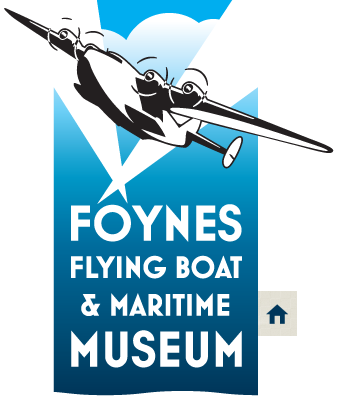
Flying Boat Museum
Foynes
Tel. +353 069 65416
Email info@flyingboatmuseum.com
Opening hours: Open 7 days a week 9.30am-5.00pm (15th March to mid-November); 9.30am-6.00pm (June, July & August)
Admission rates: Adults €12; Seniors/Students €10; Children under 14 €6; Children under 5 FREE; Family Ticket €30 (2 adults and up to 4 children)
Renseignements pratiques

Curraghchase Caravan & Camping Park
Curraghchase Forest Park
Kilcornan
Co Limerick
V94 KP8H
Tel. +353 061 396349
Email info@curraghchasecaravanpark.ie
Spacieux, superbement situé et aménagé, Curraghchase Caravan & Camping Park se trouve au cœur de la forêt domaniale de Curraghchase, Co Limerick.
Le camping est accessible par une barrière automatique à l’entrée de la forêt. Réservation indispensable pour obtenir un code personnalisé pour ouvrir la barrière sans payer 5 € de stationnement.
Sont inclus dans le tarif : douches chaudes gratuites, sécurité 24h/24, De Vere Café sur place, aire de jeux et sentier des fées, et cuisine toute équipée.
Les animaux sont les bienvenus à Curraghchase, mais les chiens doivent être tenus en laisse au sein du camping.
Curraghchase est un camping familial servant couples et familles avec enfants. Pour le bien-être de tous, un strict couvre-feu est en place pour éviter toute nuisance sonore après 23 heures.
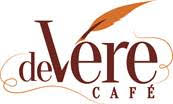 Nous avons payé €56 pour deux nuitées, soit le tarif pour 2 adultes et 2 enfants dans une tente.
Nous avons payé €56 pour deux nuitées, soit le tarif pour 2 adultes et 2 enfants dans une tente.
Curraghchase Forest Park
La forêt s’étend sur plus de 300 hectares de parc, sentiers, bois et lacs, y compris l’arboretum de Curraghchase. Ce domaine paysagé était l’ancienne demeure de la famille De Vere, dont était issu le célèbre auteur et poète Aubrey de Vere. La façade de la maison coiffe la colline dominant le parking principal et le lac.
La forêt compte six sentiers pédestres pour tous les niveaux de forme, un arboretum, deux vastes aires de jeux, des tables de pique-nique, des colonnes pour barbecue et des toilettes publiques près du parking, ainsi qu’un parcours permanent de course d’orientation.
Parking: 5 € par voiture, payable en pièces de monnaie à la barrière d’entrée.
Horaires : 7 h–21 h (1er avril–31 octobre) ; 8 h–18 h (1er novembre–31 mars)
Flying Boat Museum
Foynes
Tel. +353 069 65416
Email info@flyingboatmuseum.com
Horaires : Ouvert tous les jours 9h30–17 h (15 mars–mi novembre) ; 9h30–18 h juin, juillet et août)
Tarifs : adulte 12 € ; 3e âge/étudiant 10 € ; enfants (jusqu’à 14 ans) 6 € ; enfants de moins de 5 ans : gratuit ; famille 30 € (2 adultes et jusqu’à 4 enfants)
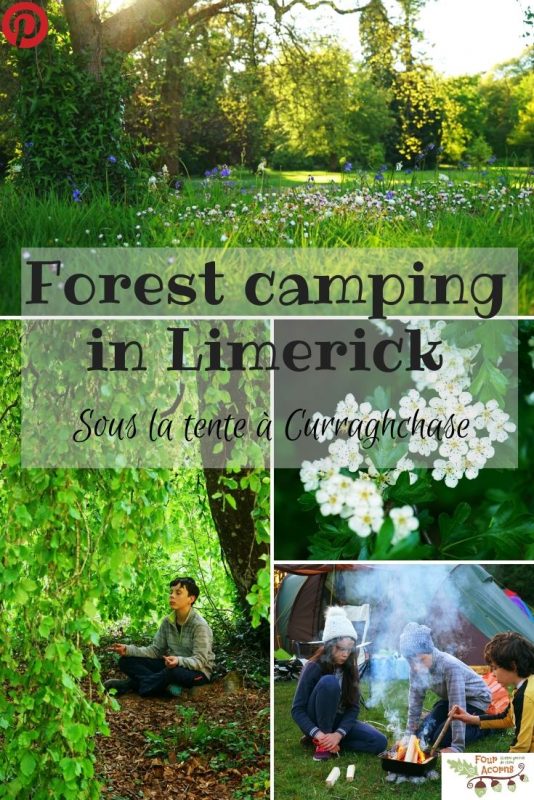
Related / Similaire
- Four Acorns go camping / Quatre graines de chêne sous la toile
- Four Acorns go camping and boating in Cavan / Quatre graines de chêne sous la tente et à la rame
- Wild camping a little closer to the stars / Camper un peu plus près des étoiles
- Four Acorns in a camper van / Quatre graines de chêne en camping car
- 10 family destinations to go wild in Ireland
Disclosure: This post contains some affiliate links. Should you choose to make a purchase after clicking on one of them, I may receive a small commission and your purchase will help support this site.
Divulgation : Cet article contient des liens partenaires. Si vous décidez d’effectuer un achat après avoir cliqué sur l’un d’eux, je recevrai une commission qui contribuera à soutenir ce site.
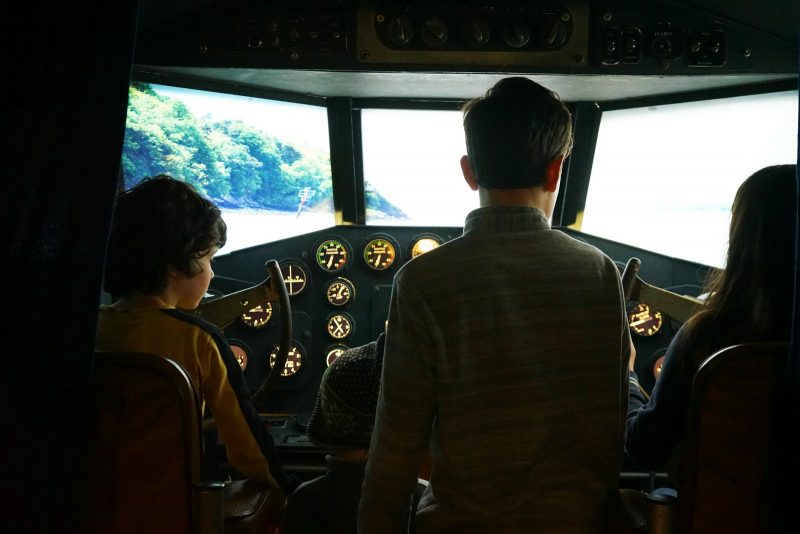
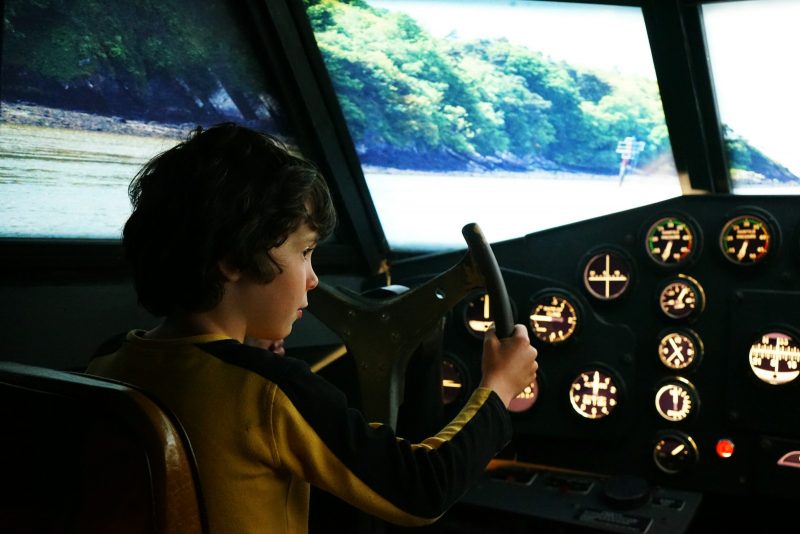
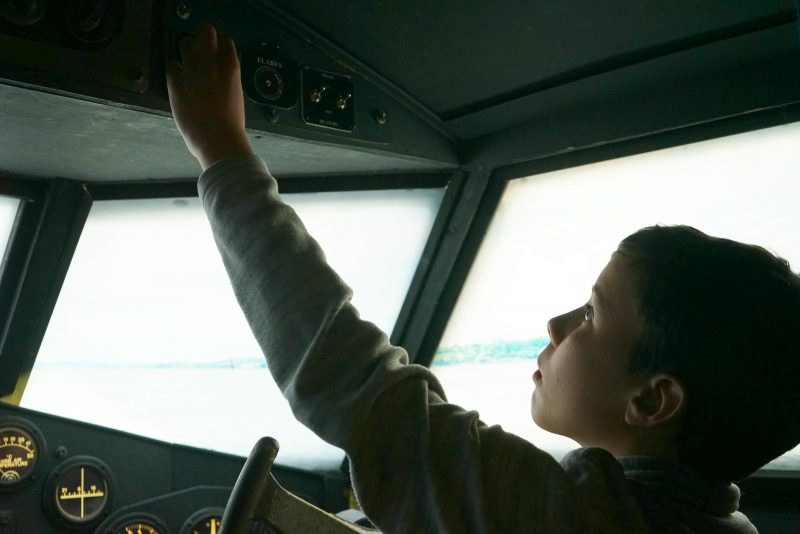
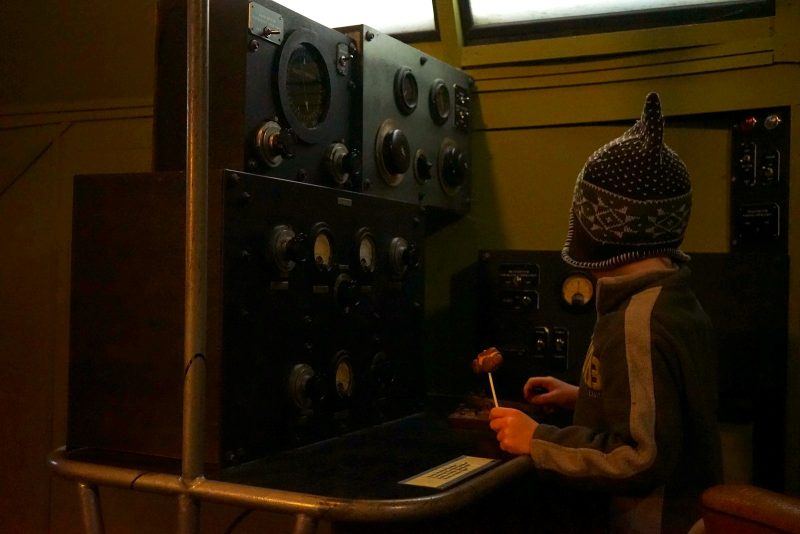
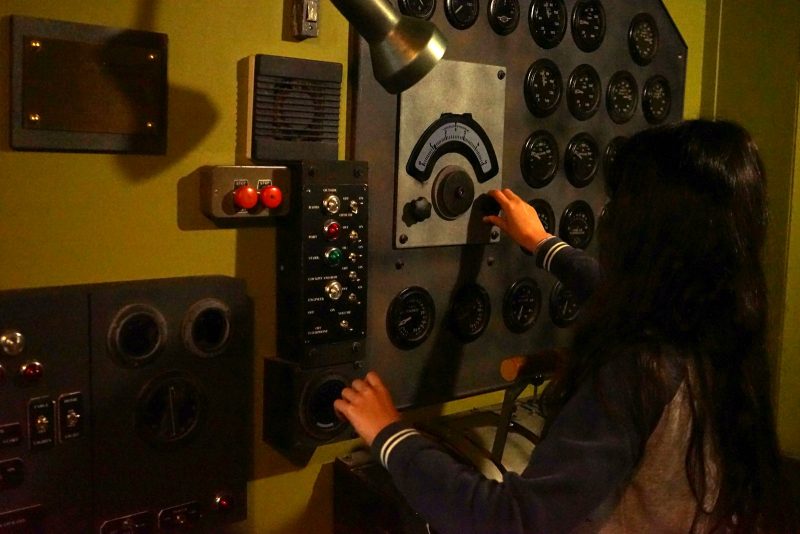
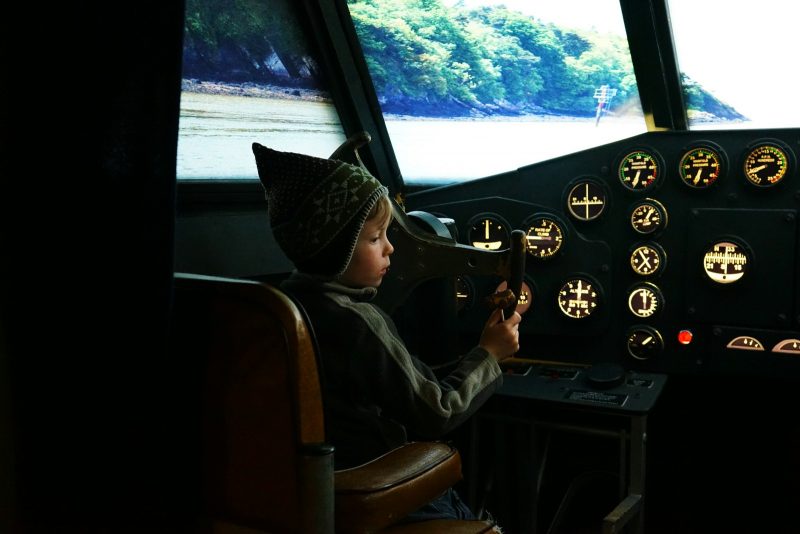
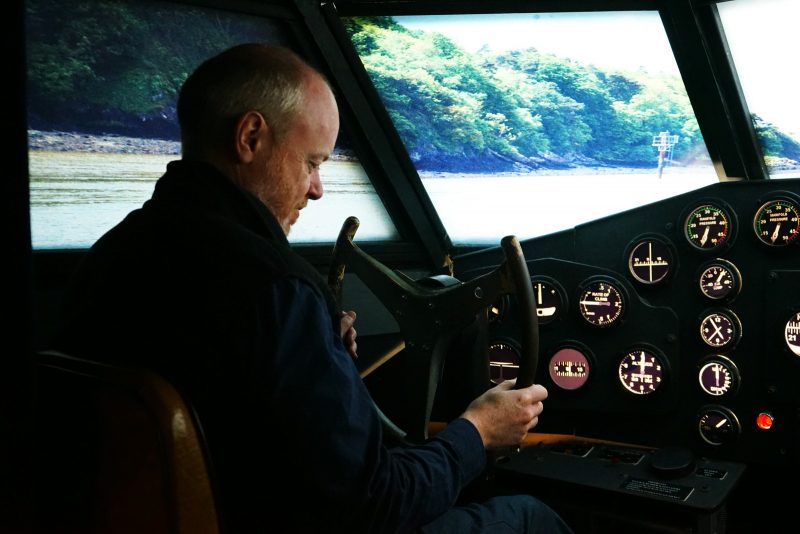
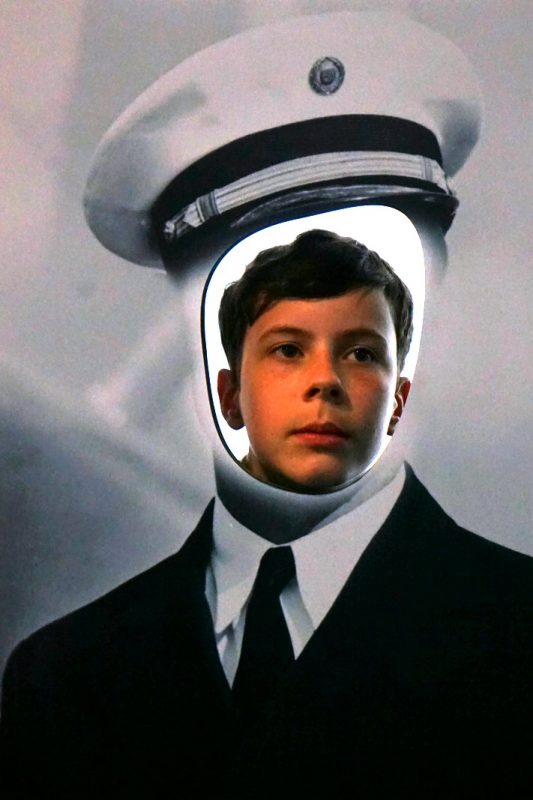
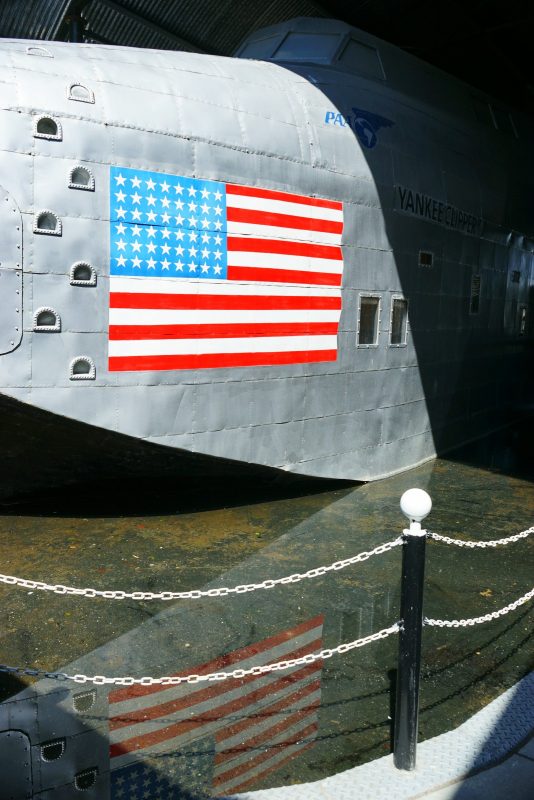
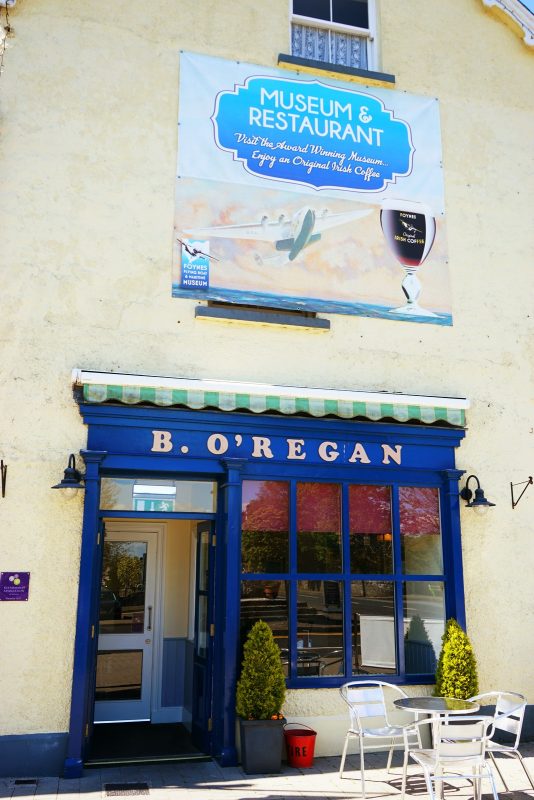






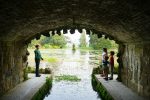 Previous Post
Previous Post Next Post
Next Post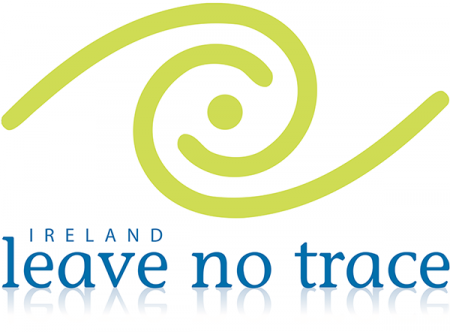
What a stunningly well written piece x
The photos ! So professional in their simplicity, perfectly capture the magic , sense of wonder & joy of childhood x
-très bien écrit .
Thank you so much for this fab comment, Sabrina – it makes my day! Thank you also for taking the time to write a few words here on the blog, it always means a lot.
Très touchée, merci 😉
hope to do camping with my boy when he grows up a bit:) #farawayfiles
I love how resourceful you all are and how at one with nature you have brought your kids up to be. It looks like another great adventure for you all and more amazing memories for your kids. A beautiful part of Ireland too, one day I would like to tour there myself. #CountryKids
I love reading about all your camping adventures, Annette. This sounds like a wonderful campsite with lots of interesting things to see and do nearby. Thanks so much for sharing on #farawayfiles
Such a wonderful location for an adventure and with the museum as well. Going to look into that game, something we’d enjoy too I think #countrykids
Curraghchase looks like a beautiful camping site and other than a cold first night, it sounds like you had a great camping trip. Your photos are always so beautiful. I love the ones of the acorns helping to pitch the tent and exploring Curraghchase. It looks like a magical place with plenty of scope for imagination. I’ve never heard of Mölkky – it looks like a fun game though. What a great idea to use a square cake tin as a makeshift fire pit – much better than a disposable barbecue! Thank you for sharing your camping trip with #CountryKids
Your photos are beautiful! I live not too far from Curraghchase (~15 mins) and have been going there since I was a child. I still love going there, my eldest daughter and I went camping there last Summer and had a great time. We brought our bikes to avail of the many trails around the park. It’s lovely to hear from the prospective of someone who has visited the area for the first time.
So happy my photos managed to do justice to the place you know so well and enjoy so much, Alan. Thank you for taking the time to write a few words, very appreciated!
Annette